Biology Test 2
0.0(0)
0.0(0)
Card Sorting
1/120
Earn XP
Description and Tags
Study Analytics
Name | Mastery | Learn | Test | Matching | Spaced |
|---|
No study sessions yet.
121 Terms
1
New cards
The Fundamental Units of Life
.All organisms are made of cells \n .The cell is the simplest collection of matter that can be alive \n .All cells are related by their descent from earlier cells \n .Cells can differ substantially from one another but share common features
2
New cards
Basic features found in all cells (prokaryotic and eukaryotic):
.Plasma membrane .Semifluid substance called cytosol. (The cytoplasm refers to the interior area within the plasma membrane.)
.Chromosomes (carry genes)
.Ribosomes (make proteins)
.Chromosomes (carry genes)
.Ribosomes (make proteins)
3
New cards
Prokaryotic cells are characterized by having
.No membrane-bound organelles (usually) \n .No nucleus \n .DNA in an unbound region called the nucleoid \n .Cytoplasm bound by the plasma membrane \n .Many prokaryotic cells have a peptidoglycan cell wall. (In contrast, plants have a cellulose cell wall; fungi have chitin cell walls.)
4
New cards
Prokaryotic “organelles”
Some prokaryotes have intracellular regions with specific functions, like organelles. Some are even surrounded by membrane
5
New cards
structures sometimes found in prokaryotes
.a flagellum (plural, flagella) is a threadlike structure made of protein fibers that extends from the cell surface- may be one or many- aids in locomotion and feeding \n . pilus (plural, pili) is a short appendage- aids in attaching to substrates and in exchanging genetic information between cells \n .capsule is a polysaccharide coating outside the cell wall that protects the cell from viruses, toxins, and engulfment by other cells
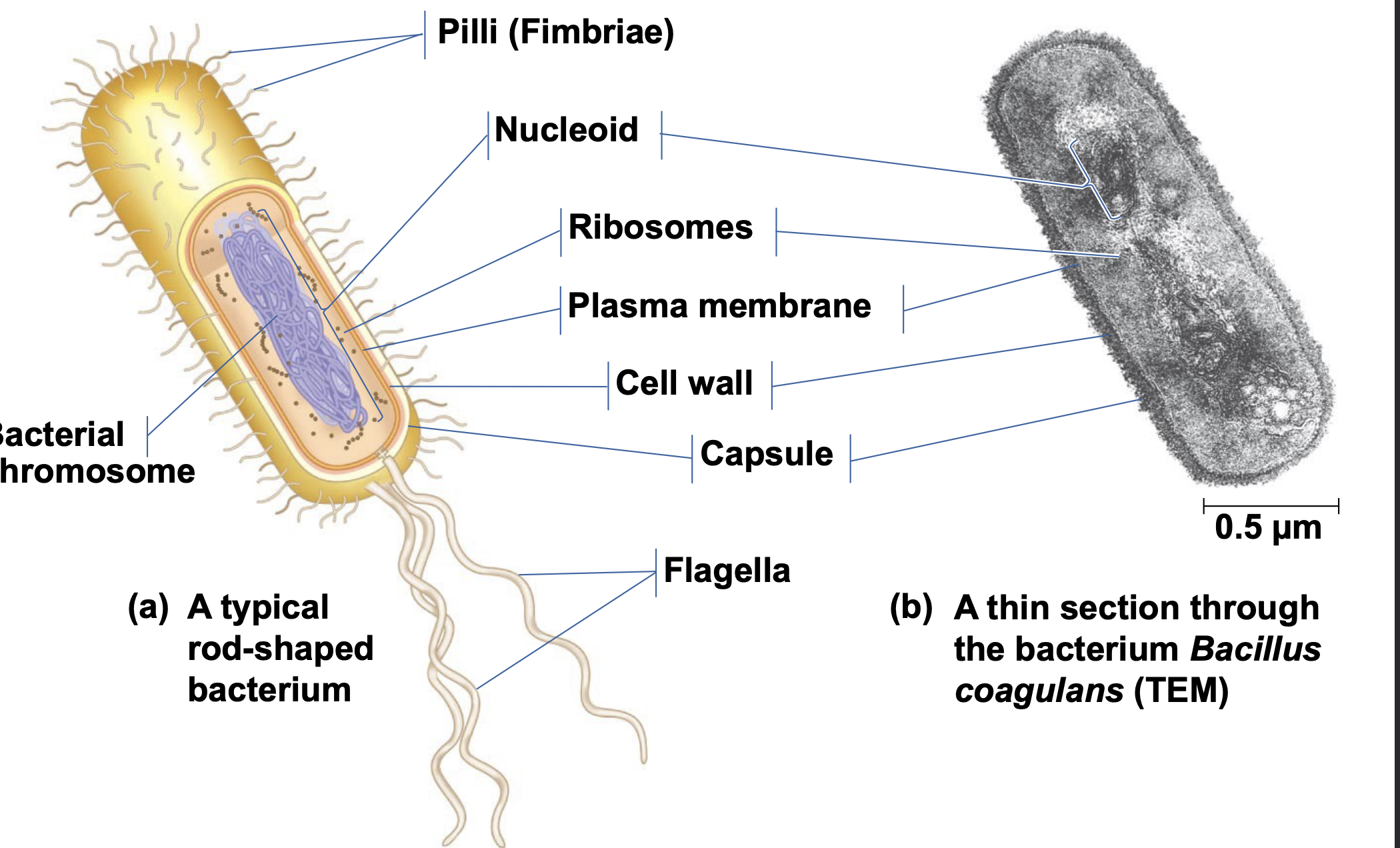
6
New cards
Eukaryotic cells are characterized by having
.Membrane-bound organelles (numerous) \n .DNA in a nucleus that is bounded by a membranous nuclear envelope \n .Cytoplasm in the region between the plasma membrane and nucleus \n .Eukaryotic cells are generally much larger than prokaryotic cells
.Plasma membrane \n • Nucleus \n • Endoplasmic reticulum (smooth/rough) \n • Golgi body \n • Vesicles \n • Mitochondria \n • Cytoskeleton \n • Chloroplasts (only in plants) \n • Central vacuole (only in plants) \n • Lysosome (only in animals)
.Plasma membrane \n • Nucleus \n • Endoplasmic reticulum (smooth/rough) \n • Golgi body \n • Vesicles \n • Mitochondria \n • Cytoskeleton \n • Chloroplasts (only in plants) \n • Central vacuole (only in plants) \n • Lysosome (only in animals)

7
New cards
Eukaryotes sometimes have
.Some have flagella or cilia \n .Some have cell walls (plants, fungi, some protists, but not animals)

8
New cards
Plasma Membrane info
.The plasma membrane is a selective barrier that allows sufficient passage of oxygen, nutrients, and waste to service the volume of every cell \n .The plasma membrane is the outermost membrane, separating the inside of the cell from the outside. \n .Cell membranes are phospholoipid bilayers containing many other lipids and a variety of proteins. \n .Proteins in the plasma membrane often have carbohydrate chains attached to their outer surface (glycoproteins). These carbohydrate chains are important in cell-cell recognition.
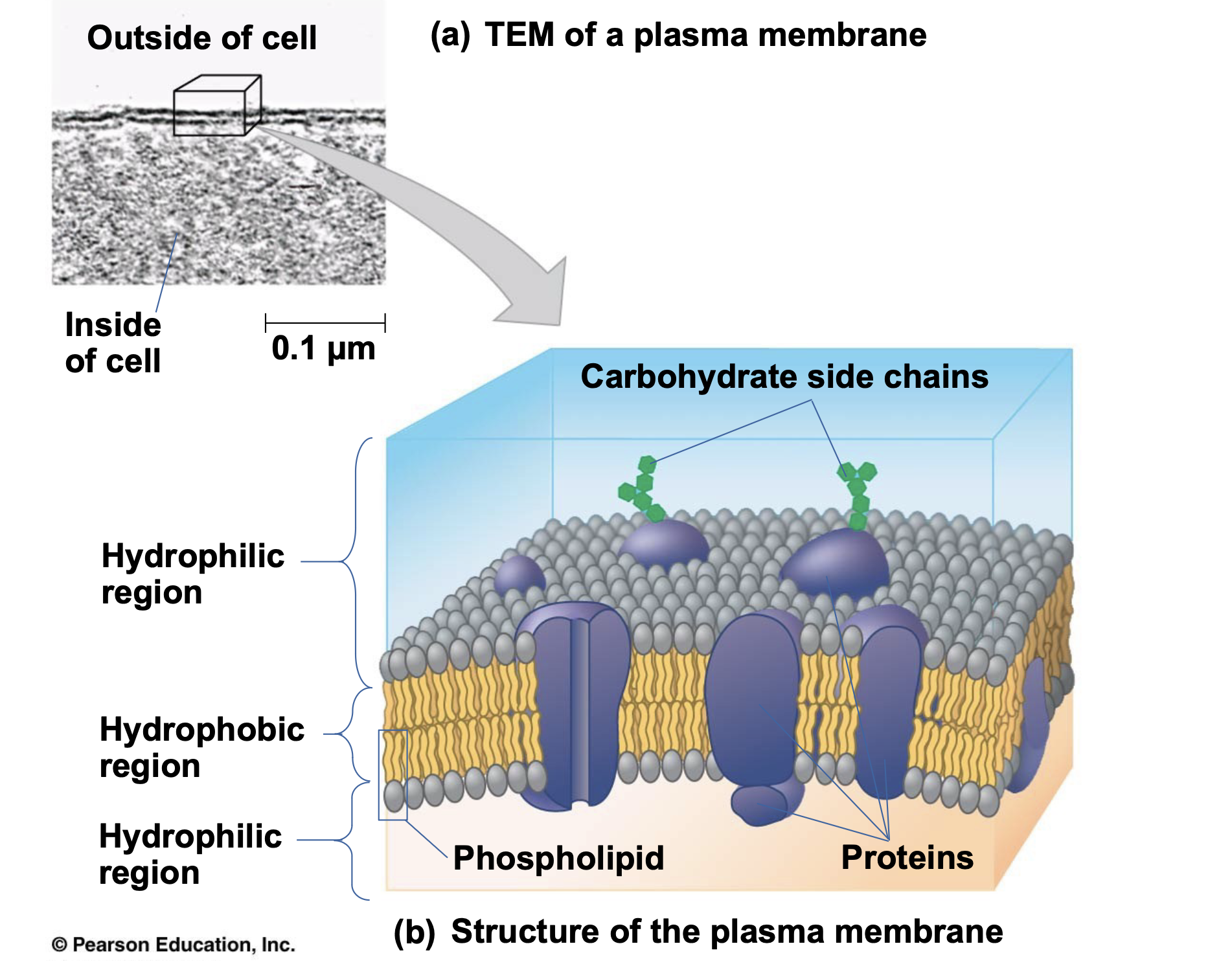
9
New cards
The Nucleus and its Structure
.The nucleus contains most of the cell’s genes and is usually the most conspicuous organelle \n .The nuclear envelope encloses the nucleus, separating it from the cytoplasm \n .The nuclear membrane is a double membrane; each membrane consists of a lipid bilayer
.Pores regulate the entry and exit of molecules from the nucleus \n .The nuclear size of the envelop is lined by the nuclear lamina, which is composed of proteins and maintains the shape of the nucleus
.Pores regulate the entry and exit of molecules from the nucleus \n .The nuclear size of the envelop is lined by the nuclear lamina, which is composed of proteins and maintains the shape of the nucleus

10
New cards
Genetics and Proteins in Nucleus
.In the nucleus, DNA is organized into discrete units called chromosomes \n .Each chromosome is composed of a single DNA molecule associated with proteins \n .The DNA and proteins of chromosomes are together called chromatin

11
New cards
Ribosomes
.Ribosomes are complexes made of ribosomal RNA (rRNA) and protein \n .Ribosomes carry out protein synthesis and are found in the cytoplasm (free ribosomes) and to the outside of the endoplasmic reticulum or the nuclear envelope (membrane-associated ribosomes) \n .The nucleolus is located within the nucleus and is the site of ribosomal RNA (rRNA) synthesis
12
New cards
The endomembrane system consists of
.Nuclear envelope \n .Endoplasmic reticulum \n .Golgi apparatus \n .Lysosomes \n .Vacuoles \n .Plasma membrane \n .These components are either continuous (joined by shared membrane) or transfer components from one to another by vesicles
13
New cards
What does the endomembrane system does
The endomembrane system regulates protein traffic and performs metabolic functions in the cell
14
New cards
The Endoplasmic Reticulum
.It is the biosynthetic factory
.The endoplasmic reticulum (ER) accounts for more than half of the total membrane in many eukaryotic cells \n .The ER membrane is continuous with the nuclear envelope \n .There are two distinct regions of ER: The Smooth ER, which lacks ribosomes. and the Rough ER, whose surface is studded with ribosomes
.The endoplasmic reticulum (ER) accounts for more than half of the total membrane in many eukaryotic cells \n .The ER membrane is continuous with the nuclear envelope \n .There are two distinct regions of ER: The Smooth ER, which lacks ribosomes. and the Rough ER, whose surface is studded with ribosomes

15
New cards
Functions of Smooth ER
\n .Synthesizes lipids \n .Metabolizes carbohydrates \n .Detoxifies drugs and poisons \n .Stores calcium ions
16
New cards
Functions of Rough ER
.Has bound ribosomes for protein synthesis. The cell’s glycoproteins (proteins covalently bonded to carbohydrates) are produced at the rough ER \n .Distributes transport vesicles, secretory proteins surrounded by membranes \n .Also synthesizes membrane for the cell
17
New cards
The Golgi Apparatus
.Shipping and Receiving Center \n .The Golgi apparatus consists of flattened membranous sacs called cisternae \n .Modifies products of the ER \n .Manufactures certain macromolecules (such as cell wall polysaccharides in plants and fungi) \n .Sorts and packages materials into transport vesicles
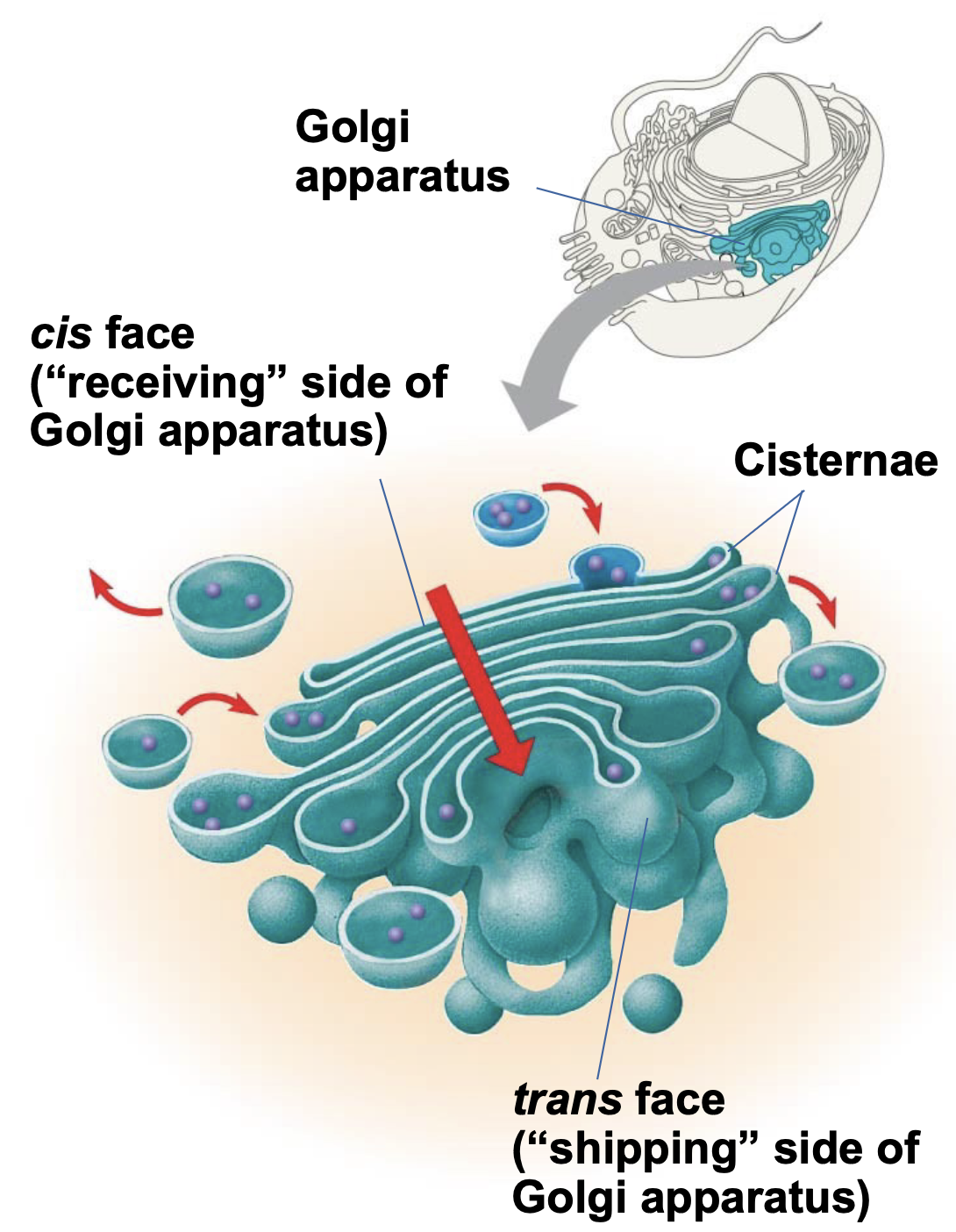
18
New cards
The endomembrane system, protein traffic, and metabolic functions
The endomembrane system regulates protein traffic and performs metabolic functions in the cell \n .Proteins synthesized by ribosomes at the rough ER are deposited into the interior of the rough ER. \n .These proteins are then carried by transport vesicles from to the Golgi apparatus, where they are often modified chemically, and then are transported from the Golgi to their final destination in the cell (or secreted) by transport vesicles.
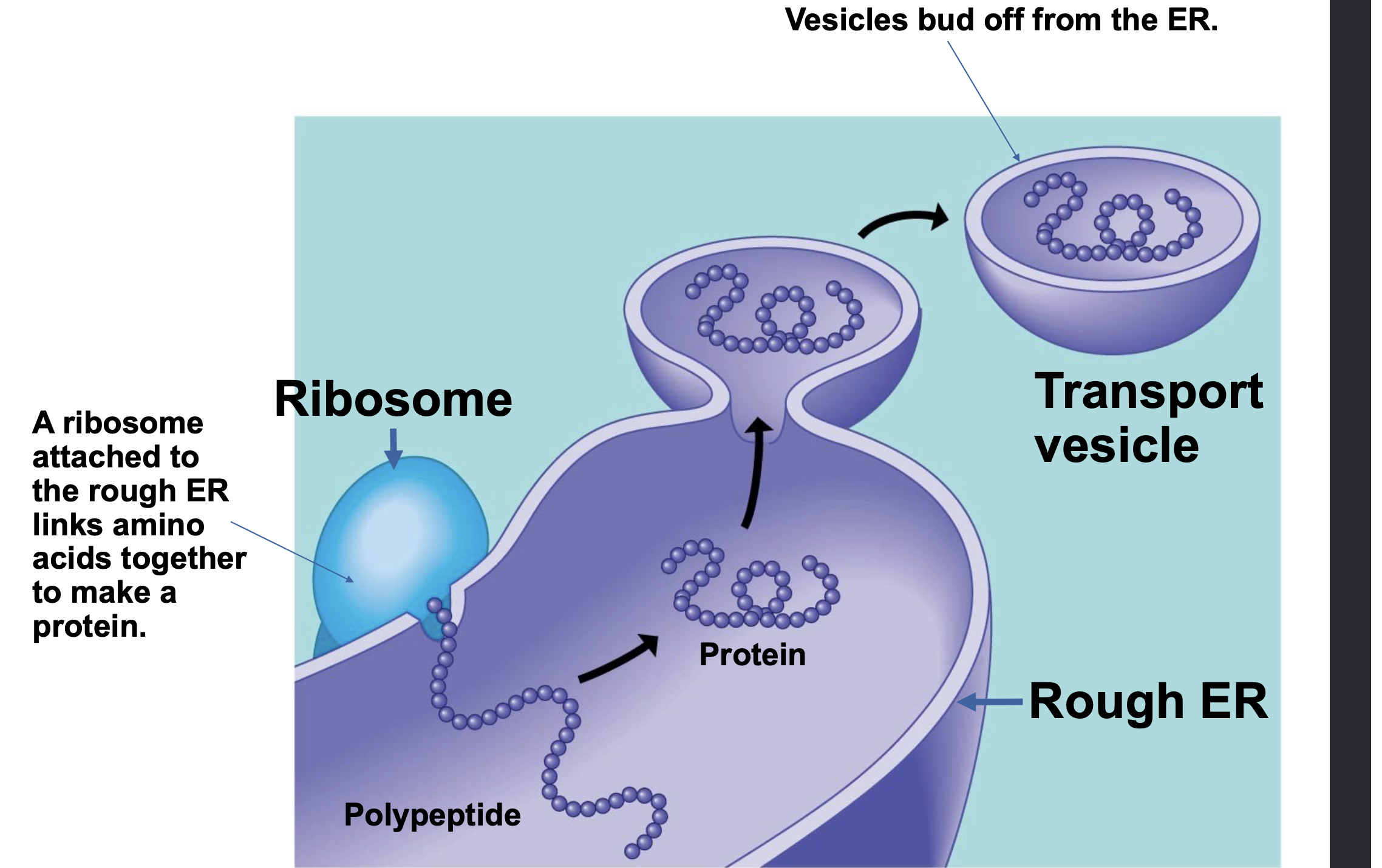
19
New cards
chloroplasts and mitochondria and portends
.Some proteins in chloroplasts and mitochondria are made by ribosomes in the cytoplasm (not bound to the ER) and imported into the organelle. \n .These proteins have signal sequences (usually at the N-terminus but sometimes internal) that target them to translocases in the organelle membrane.
.Mitochondrial proteins are imported across the outer membrane by the TOM complex and across the inner membrane by TIM complexes.
.Some chloroplast proteins are imported across two membranes by the TOC-TIC complex.
.Mitochondrial proteins are imported across the outer membrane by the TOM complex and across the inner membrane by TIM complexes.
.Some chloroplast proteins are imported across two membranes by the TOC-TIC complex.
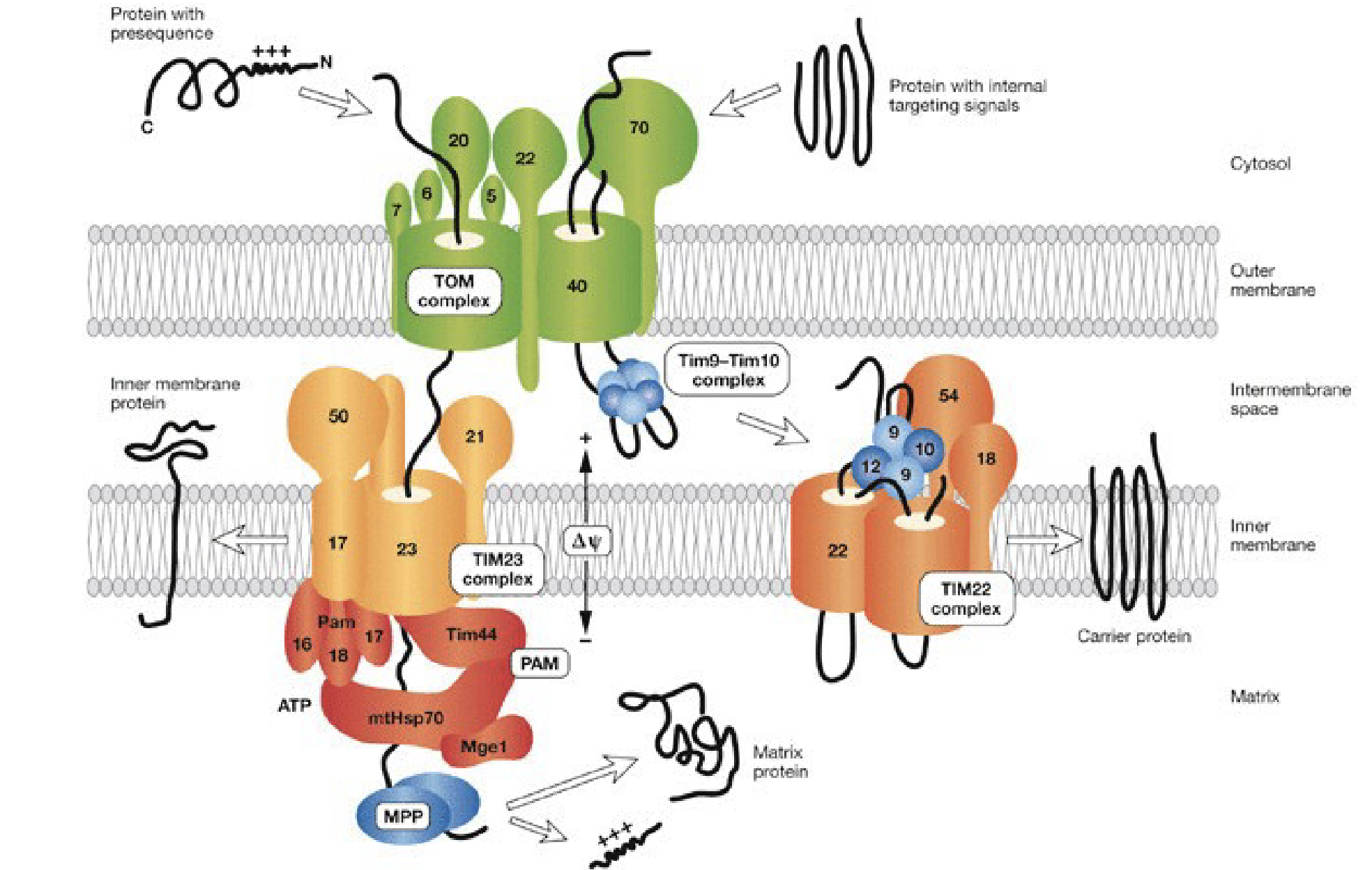
20
New cards
lysosomes
.A lysosome is a membranous sac of hydrolytic enzymes that can digest macromolecules \n .Lysosomal enzymes work best in the acidic environment inside the lysosome \n .Hydrolytic enzymes and lysosomal membranes are made by rough ER and then transferred to the Golgi apparatus for further processing
21
New cards
Phagocytosis
.Some types of cell can engulf another cell by phagocytosis; this forms a food vacuole \n .A lysosome fuses with the food vacuole and digests the molecules
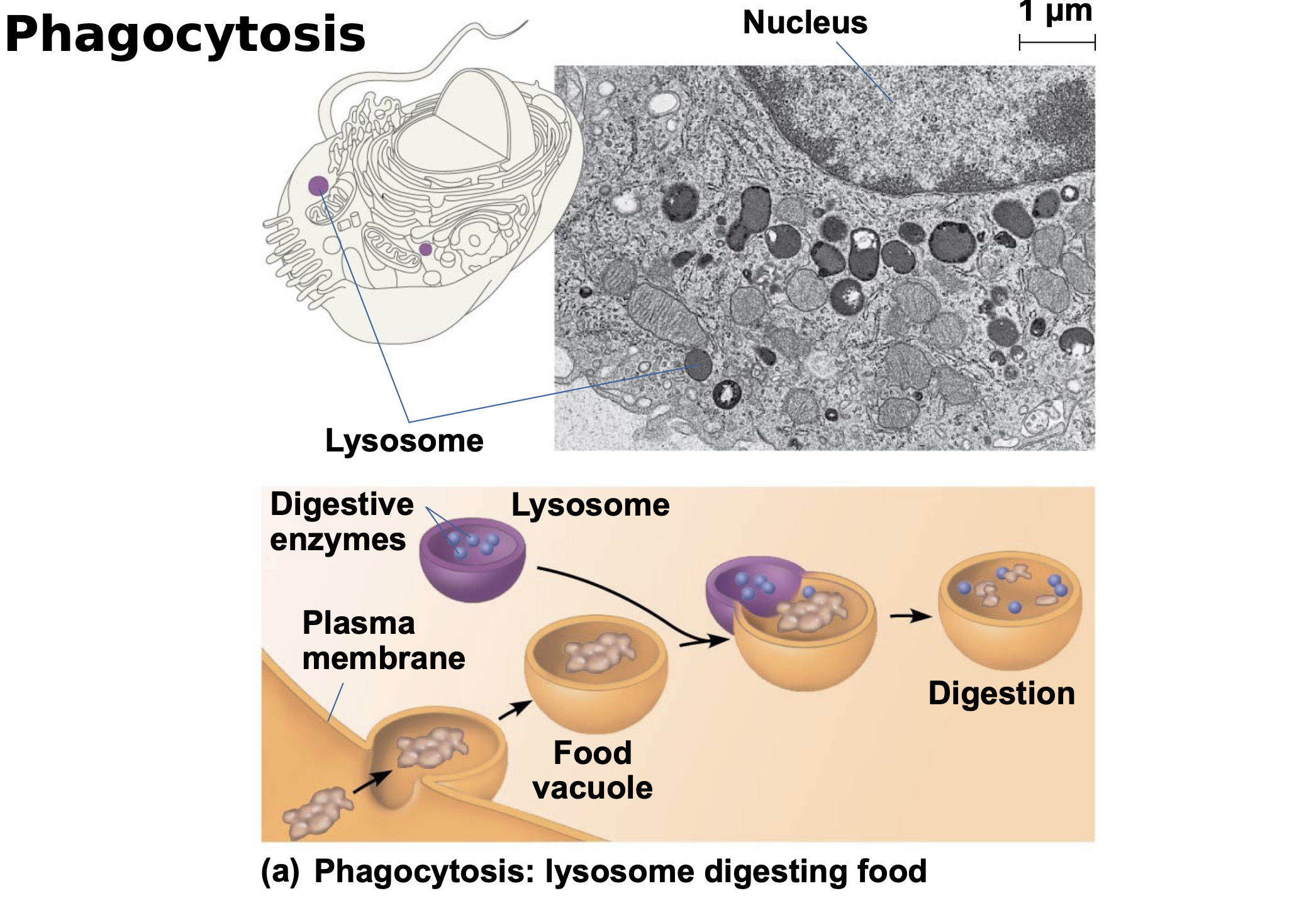
22
New cards
autophagy
.Lysosomes also use enzymes to recycle the cell’s own organelles and macromolecules, a process called autophagy
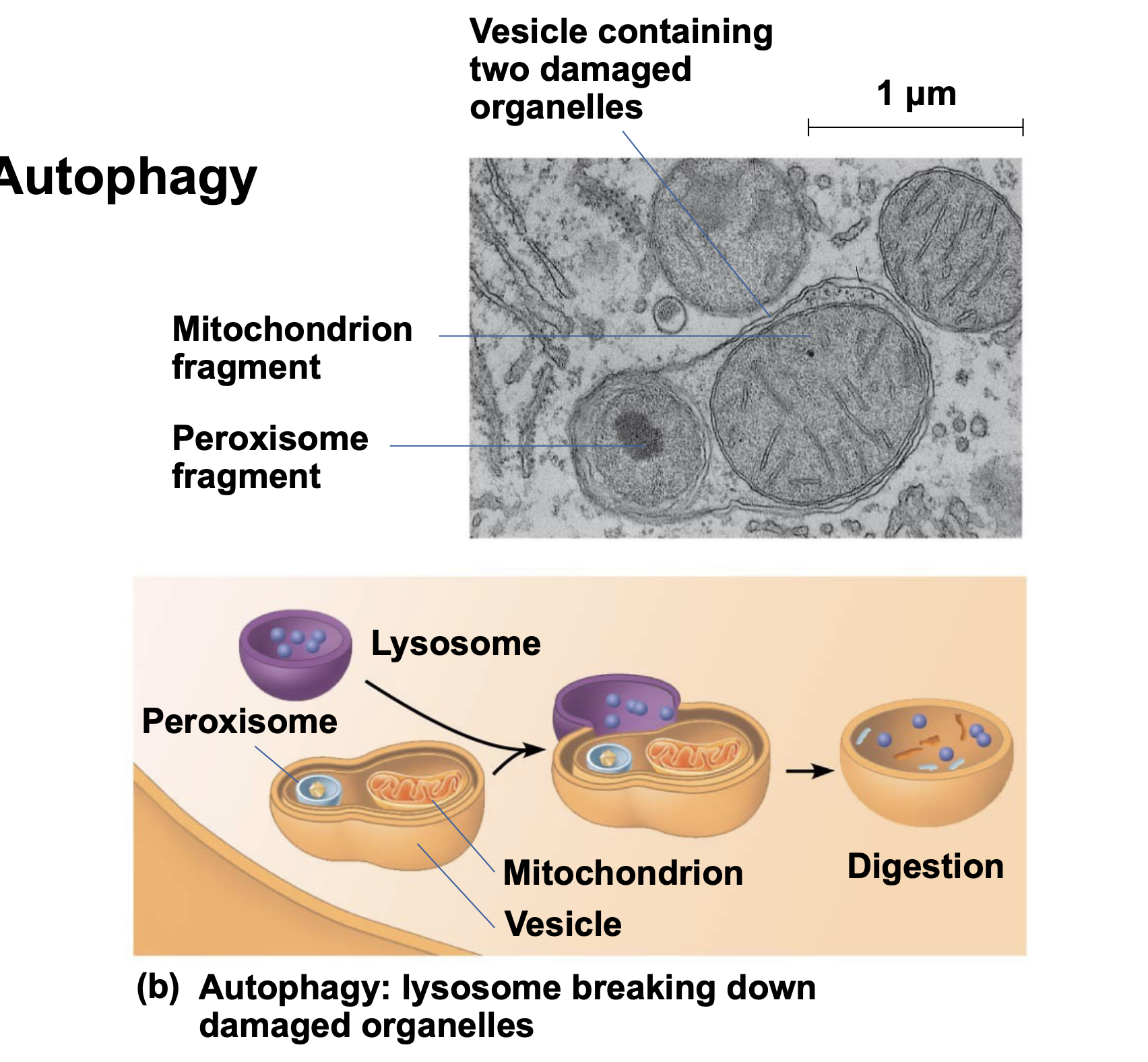
23
New cards
Vacuoles
.Diverse Maintenance Compartments \n .Vacuoles are large vesicles derived from the ER and Golgi apparatus \n .Food vacuoles are formed by phagocytosis \n .Contractile vacuoles, found in many freshwater protists, pump excess water out of cells \n .Central vacuoles, found in many mature plant cells, hold organic compounds and water
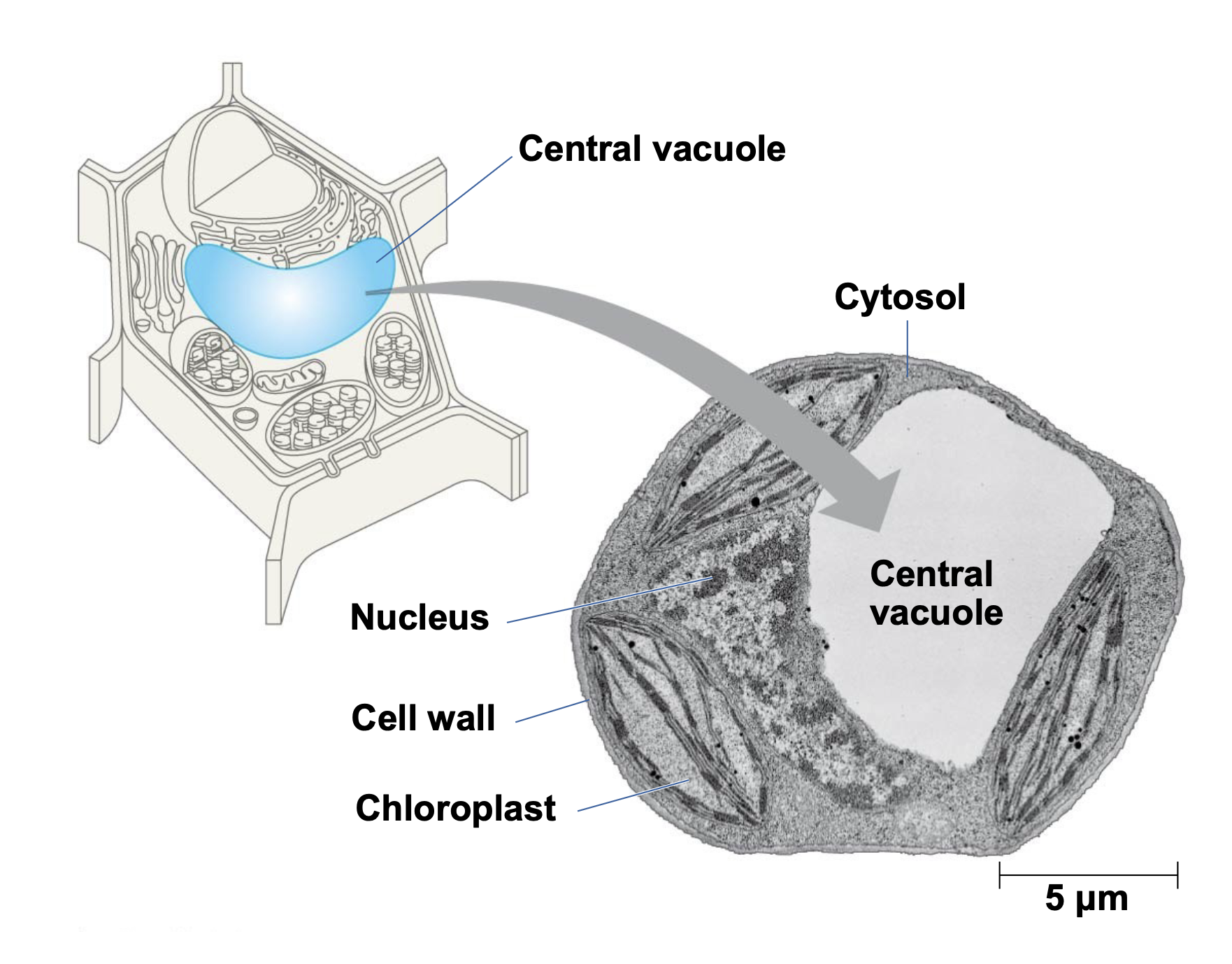
24
New cards
mitochondria and choloroplast energy
.mitochondria and chloroplasts change energy from one form to another \n .Chloroplasts, found in plants and algae, are the sites of photosynthesis.
.Mitochondria are the sites of cellular respiration, a metabolic process that uses oxygen to generate ATP
.Mitochondria are the sites of cellular respiration, a metabolic process that uses oxygen to generate ATP
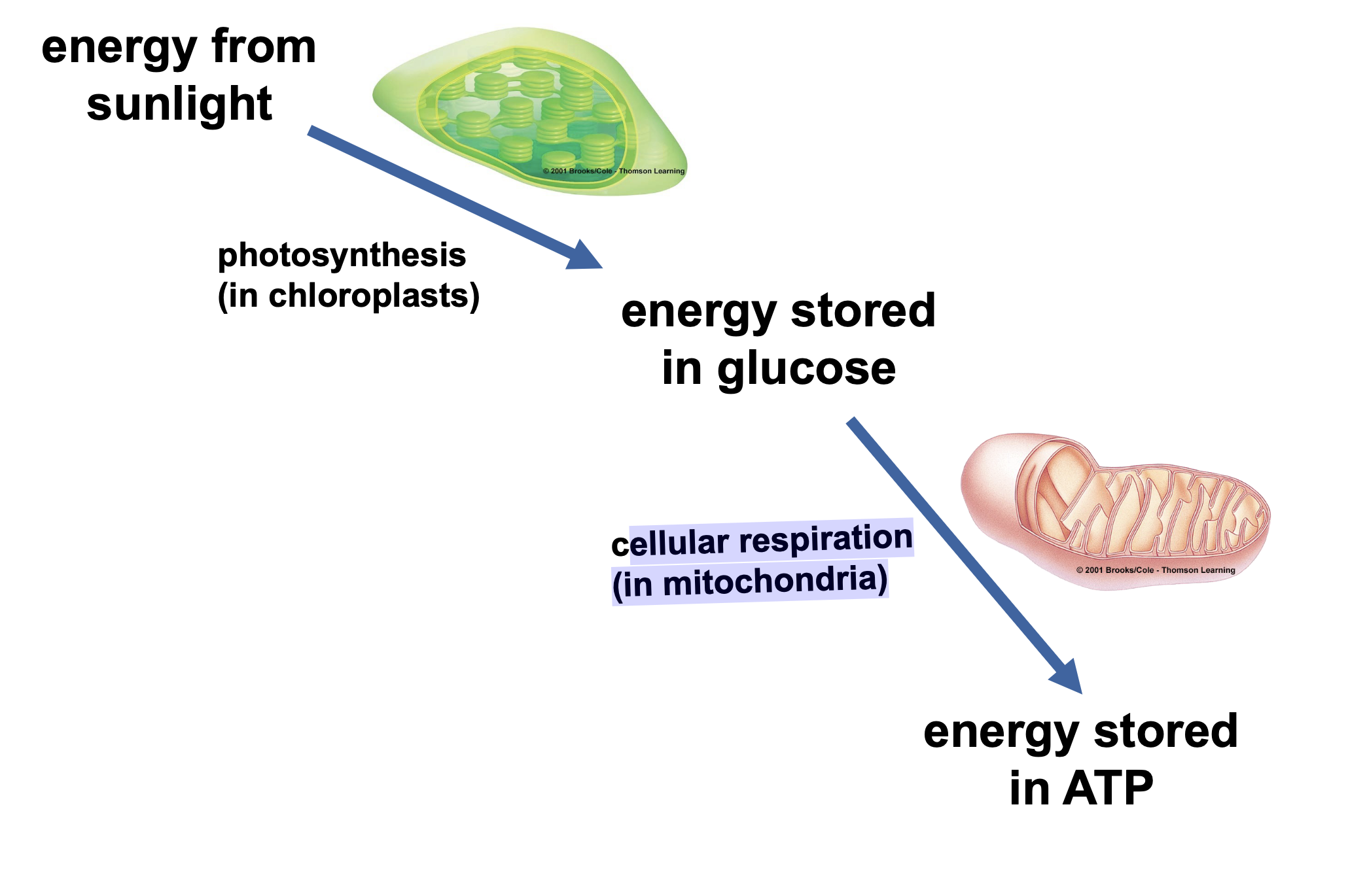
25
New cards
chloroplasts
.Chloroplasts contain the green pigment chlorophyll, \n as well as enzymes and other molecules that function in photosynthesis \n .Chloroplasts are found in leaves and other green organs of plants and in algae
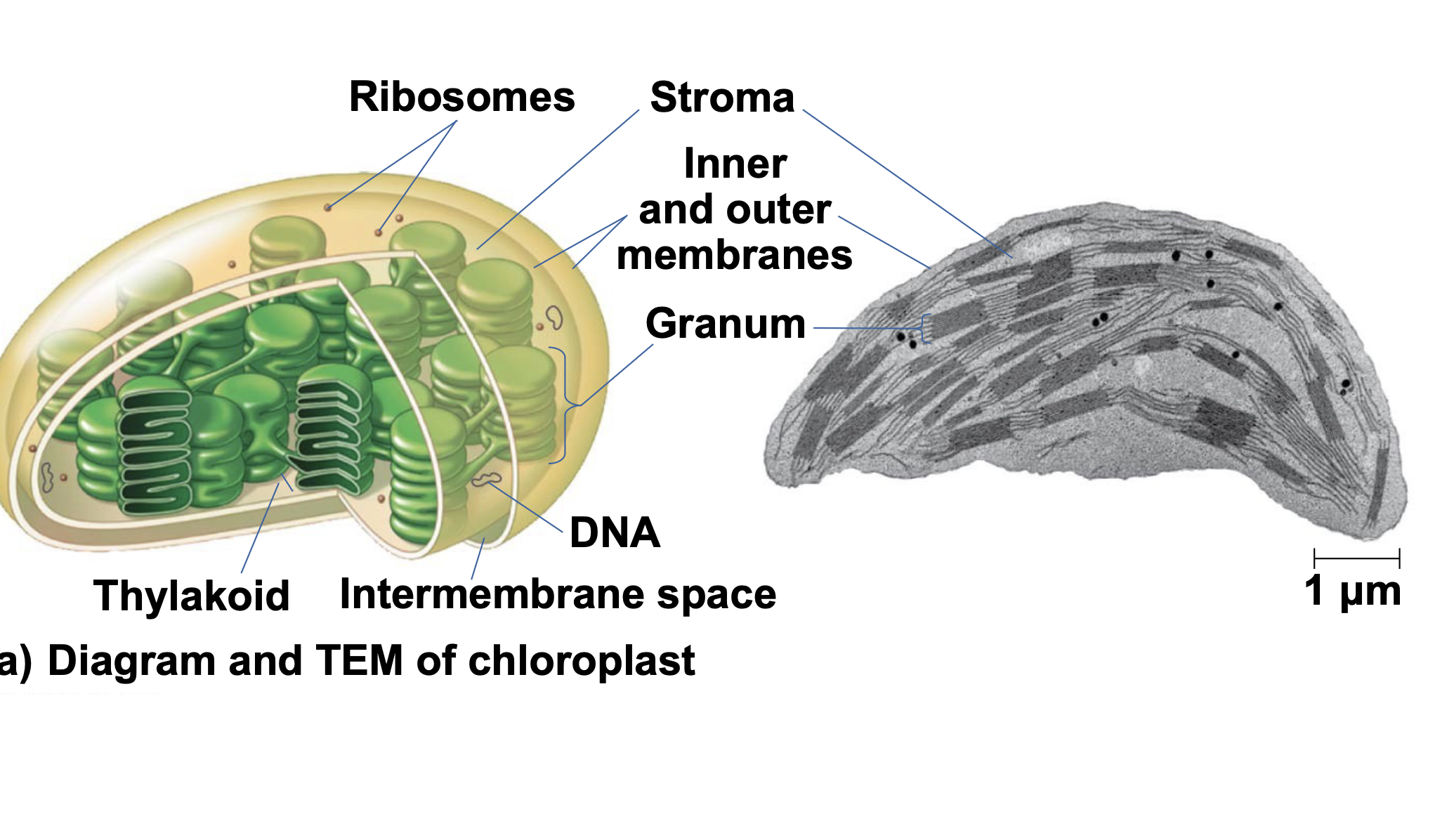
26
New cards
Mitochondria
\n .Mitochondria are in nearly all eukaryotic cells \n .They have a smooth outer membrane and an inner membrane folded into cristae \n .The inner membrane creates two compartments: intermembrane space and mitochondrial matrix \n .Some metabolic steps of cellular respiration are catalyzed in the mitochondrial matrix \n .Cristae present a large surface area for enzymes that synthesize ATP
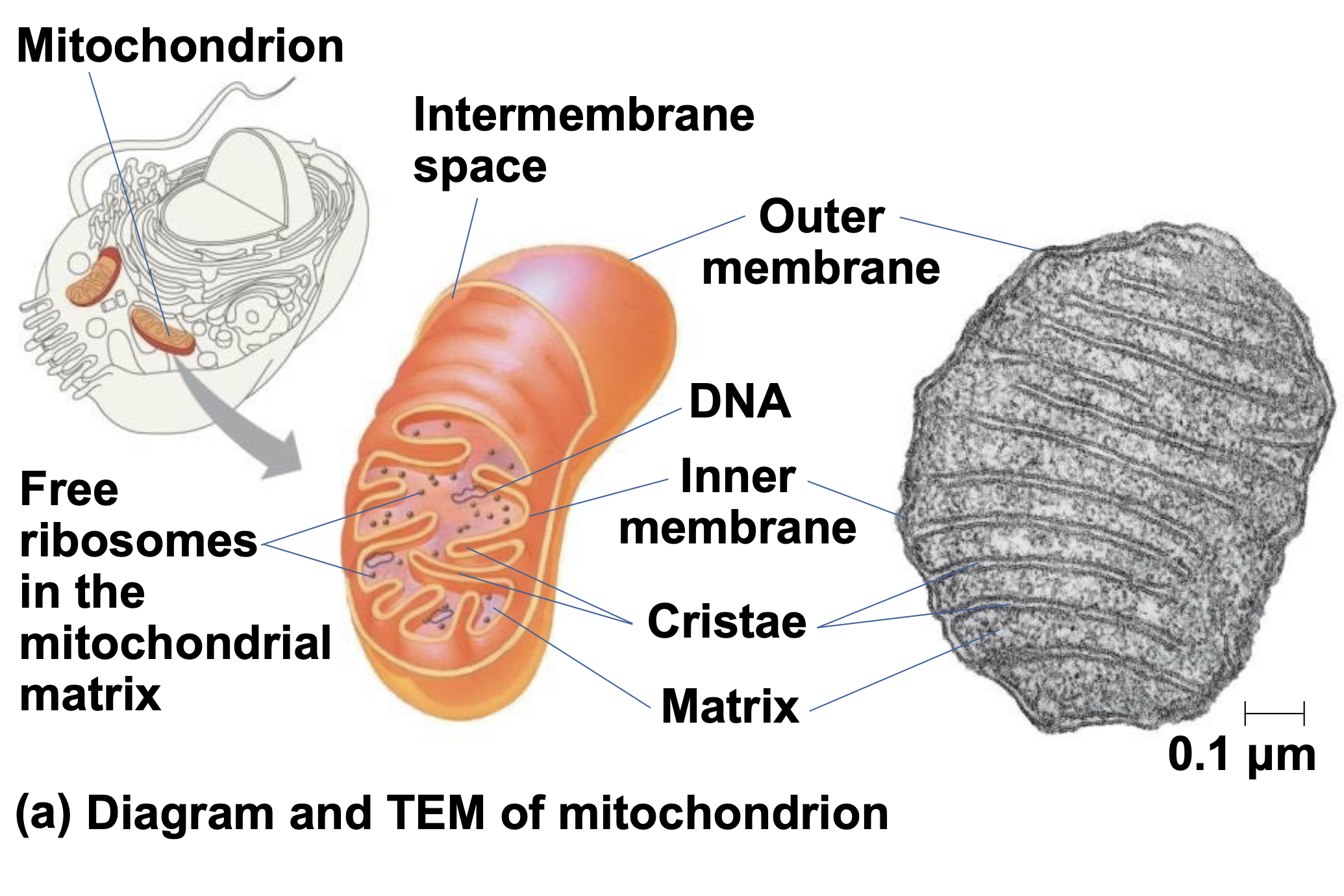
27
New cards
cytoskeleton
.The cytoskeleton is a network of fibers extending throughout the cytoplasm \n .It organizes the cell’s structures and activities, anchoring many organelles \n .It is composed of three types of molecular structures or fibers \n 1. Microtubules are the thickest of the three components of the cytoskeleton \n 2.Microfilaments, also called actin filaments, are the thinnest components \n 3. Intermediate filaments are fibers with diameters in a middle range
.The cytoskeleton helps to support the cell and maintain its shape \n .It interacts with motor proteins to produce motility \n .Inside the cell, vesicles and some organelles can travel along tracks provided by the cytoskeleton Motor proteins moving a vesicle
.The cytoskeleton helps to support the cell and maintain its shape \n .It interacts with motor proteins to produce motility \n .Inside the cell, vesicles and some organelles can travel along tracks provided by the cytoskeleton Motor proteins moving a vesicle
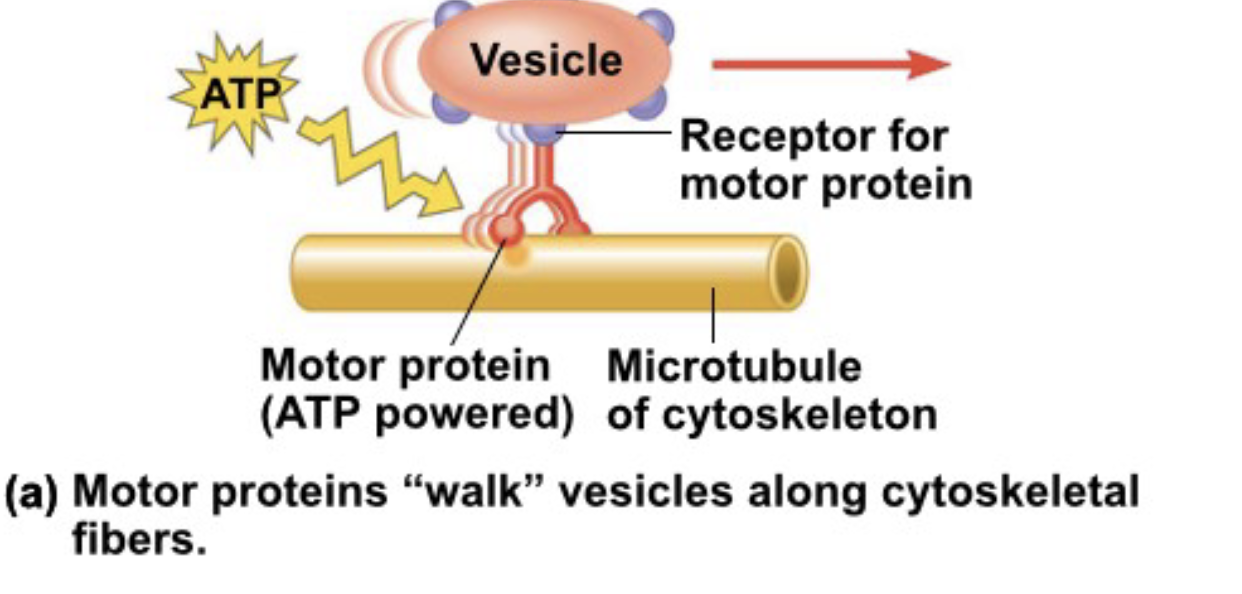
28
New cards
Cilia and Flagella
\n .Microtubules control the beating of flagella and cilia, microtubule-containing extensions that project from some cells \n .Cilia and flagella differ in their beating patterns
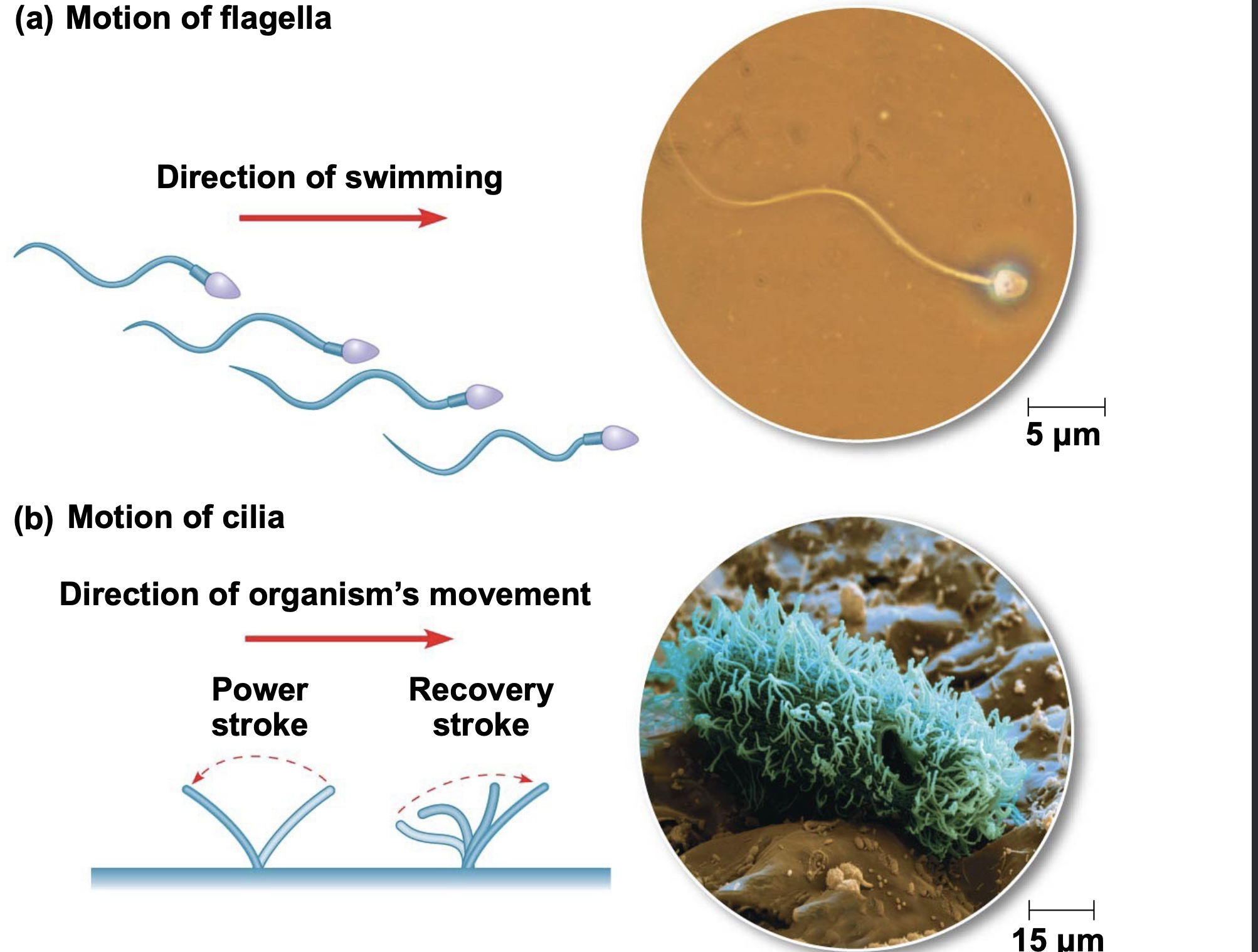
29
New cards
Filaments
Microfilaments that function in cellular motility contain the protein myosin in addition to actin \n .In muscle cells, thousands of actin filaments are arranged parallel to one another \n .Thicker filaments composed of myosin interdigitate with the thinner actin fibers \n .The myosin slides actin filaments together to cause muscle contraction
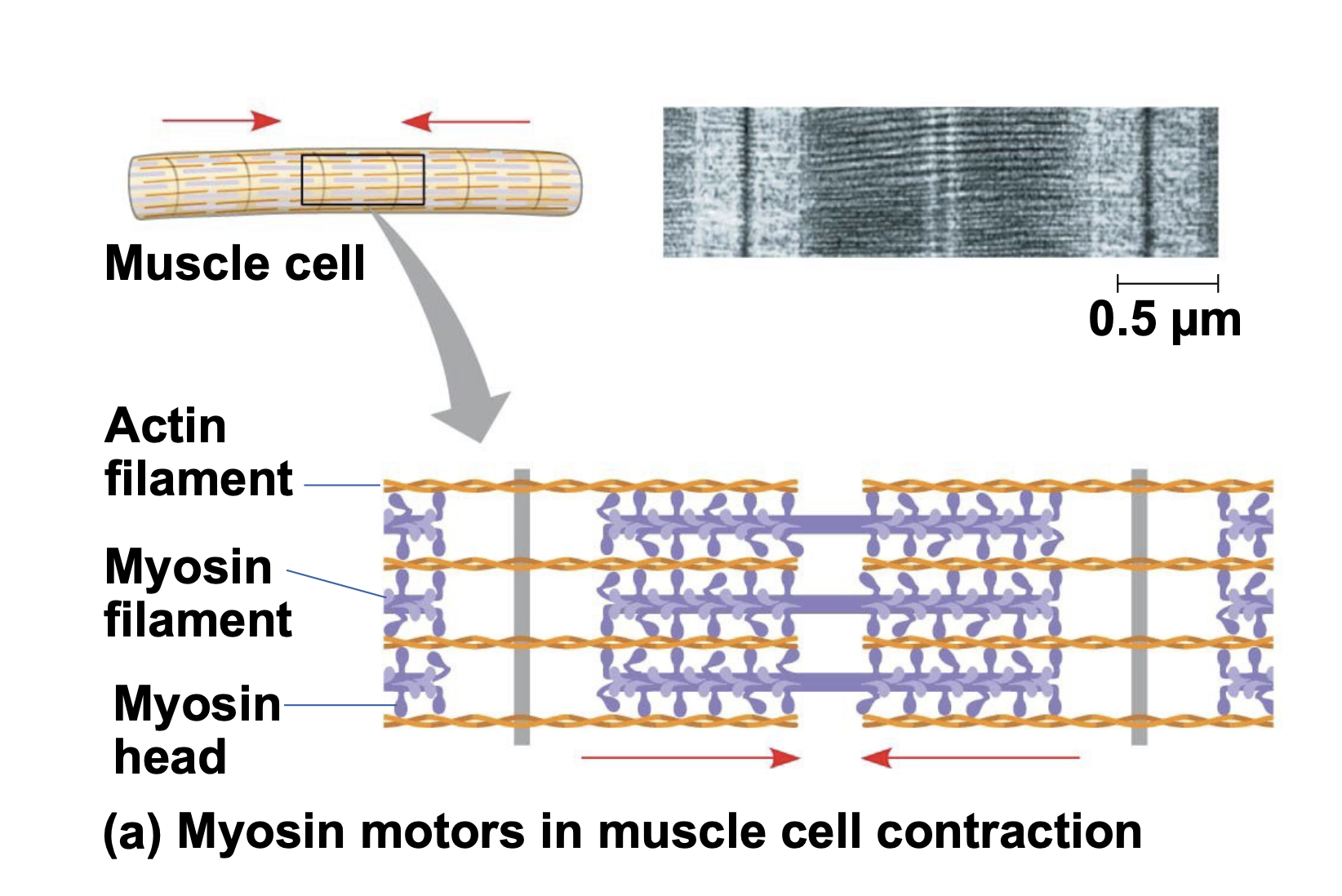
30
New cards
The Extracellular Matrix (ECM) of animals
.Animal cells lack cell walls but are covered by an elaborate extracellular matrix (ECM) \n .The ECM is made up of glycoproteins such as collagen, proteoglycans, and fibronectin \n .ECM proteins bind to receptor proteins in the plasma membrane called integrins \n .ECM can regulate a cell’s behavior by communicating with a cell through integrins
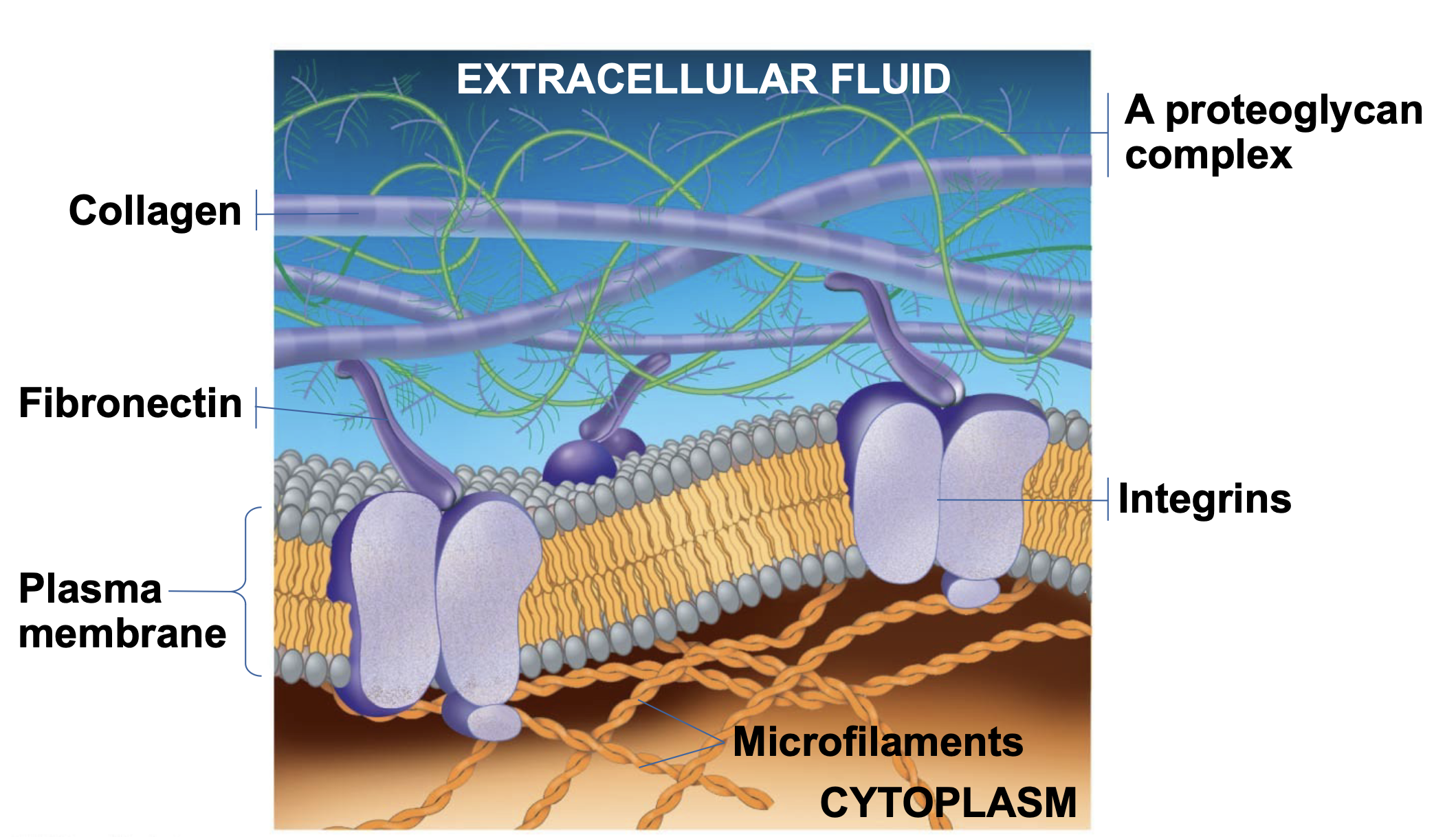
31
New cards
Tight Junctions, Desmosomes, and Gap \n Junctions in Animal Cells
.Three types of cell junctions are common in epithelial tissues \n .At tight junctions, membranes of neighboring cells are pressed together, forming a waterproof barrier \n .Desmosomes (anchoring junctions) fasten cells together into strong sheets \n .Gap junctions (communicating junctions) provide cytoplasmic channels between adjacent cells
.The pattern of cell adhesion molecules on neurons controls the formation of the brain.
.The pattern of cell adhesion molecules on neurons controls the formation of the brain.

32
New cards
Plasmodesmata in Plant Cells
Plasmodesmata are channels that perforate plant cell walls
Through plasmodesmata, water and small solutes (and sometimes proteins and RNA) can pass from cell to cell
\n
Through plasmodesmata, water and small solutes (and sometimes proteins and RNA) can pass from cell to cell
\n
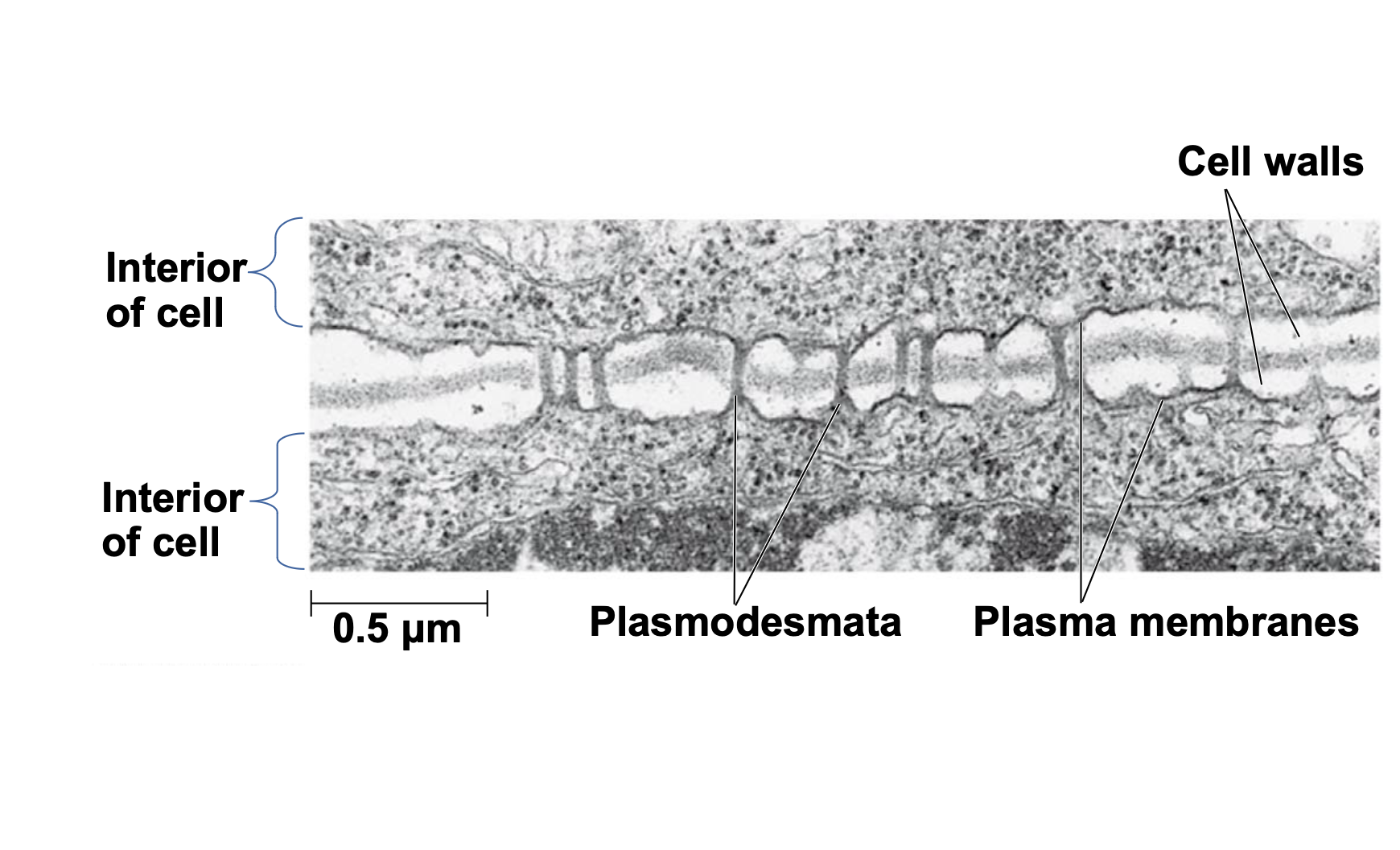
33
New cards
phospholipids
Phospholipids are the most abundant lipid in the plasma membrane \n Phospholipids are amphipathic molecules, containing hydrophobic and hydrophilic regions \n A phospholipid bilayer can exist as a stable boundary between two aqueous compartments \n Biological membranes exhibit selective permeability, allowing some substances to cross more easily than others
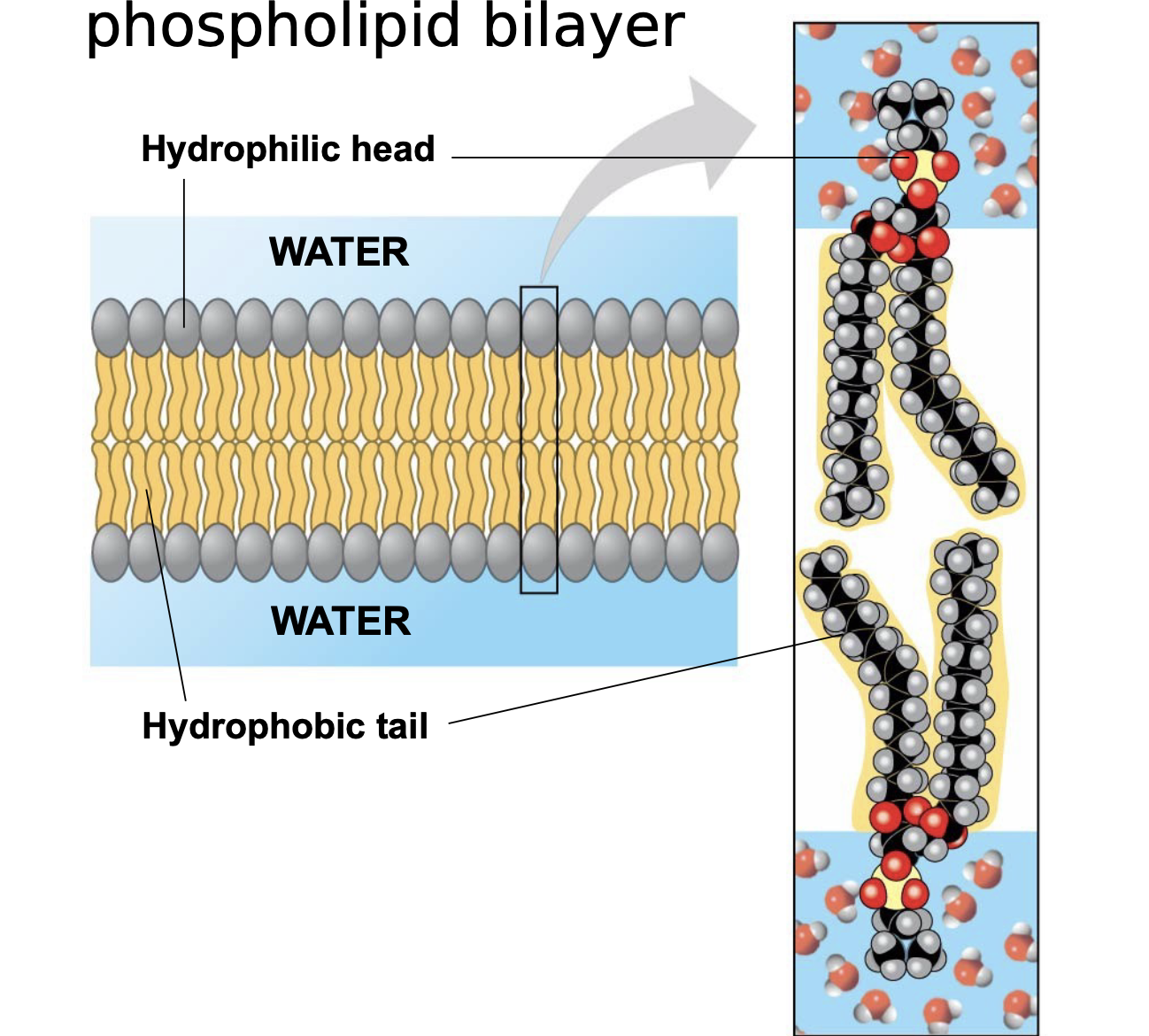
34
New cards
The Permeability of the Lipid Bilayer
Hydrophobic (nonpolar) molecules, such as hydrocarbons, can dissolve in the lipid bilayer and pass through the membrane rapidly \n Hydrophilic molecules including ions and polar molecules do not cross the membrane easily \n The interior of a phospholipid bilayer is hydrophobic and thus blocks hydrophilic molecules from passing through
35
New cards
The fluid Mosaic Model
\n .The fluid mosaic model states that a membrane is a fluid structure with a “mosaic” of various proteins embedded in it \n Proteins are not randomly distributed in the membrane
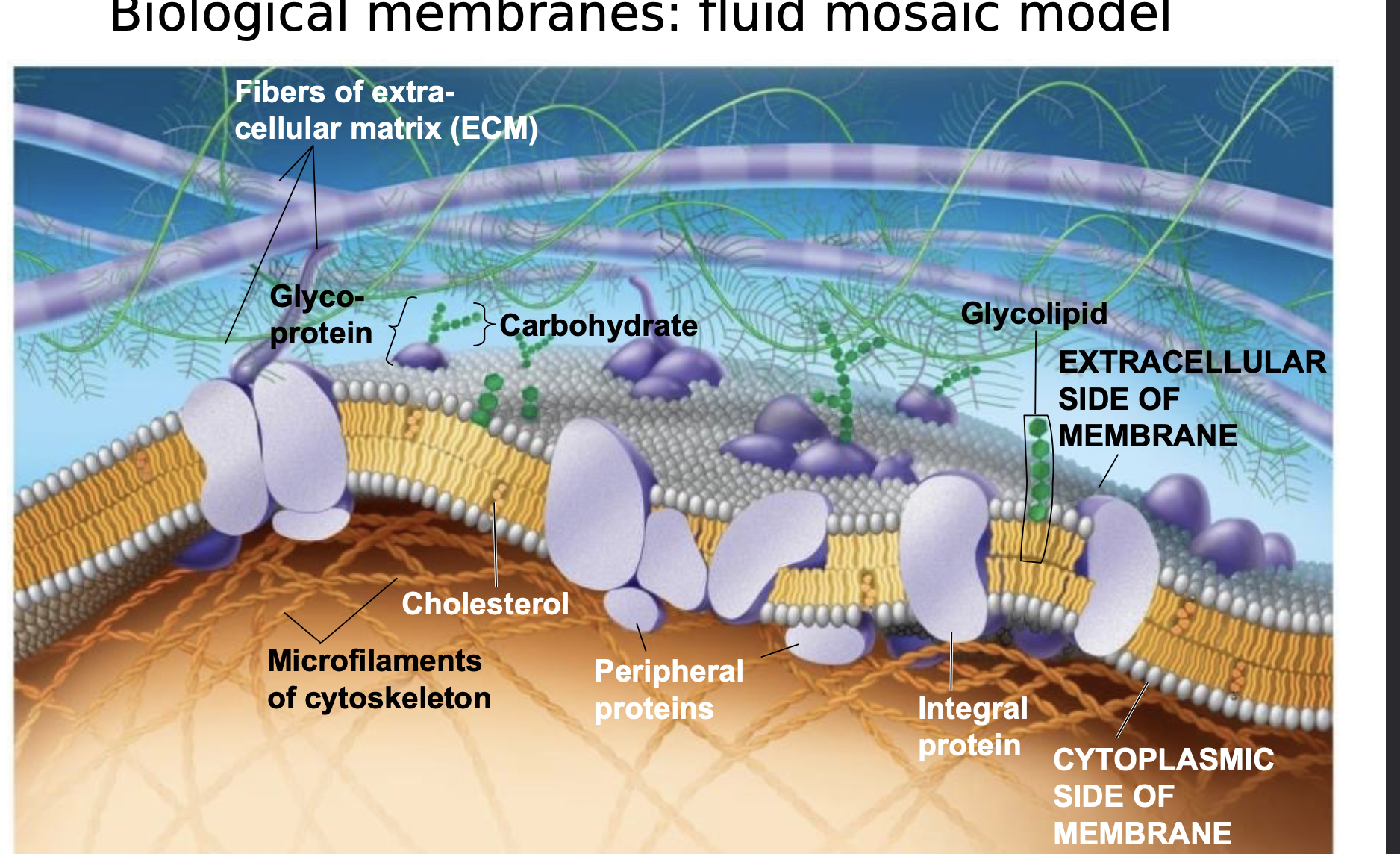
36
New cards
Peripheral , Integral, and transmembrane proteins
\n .Peripheral proteins are bound to the surface of the membrane \n .Integral proteins penetrate the hydrophobic core \n .Integral proteins that span the membrane are called transmembrane proteins \n .The hydrophobic regions of an integral protein consist of one or more stretches of nonpolar amino acids, often coiled into alpha helices
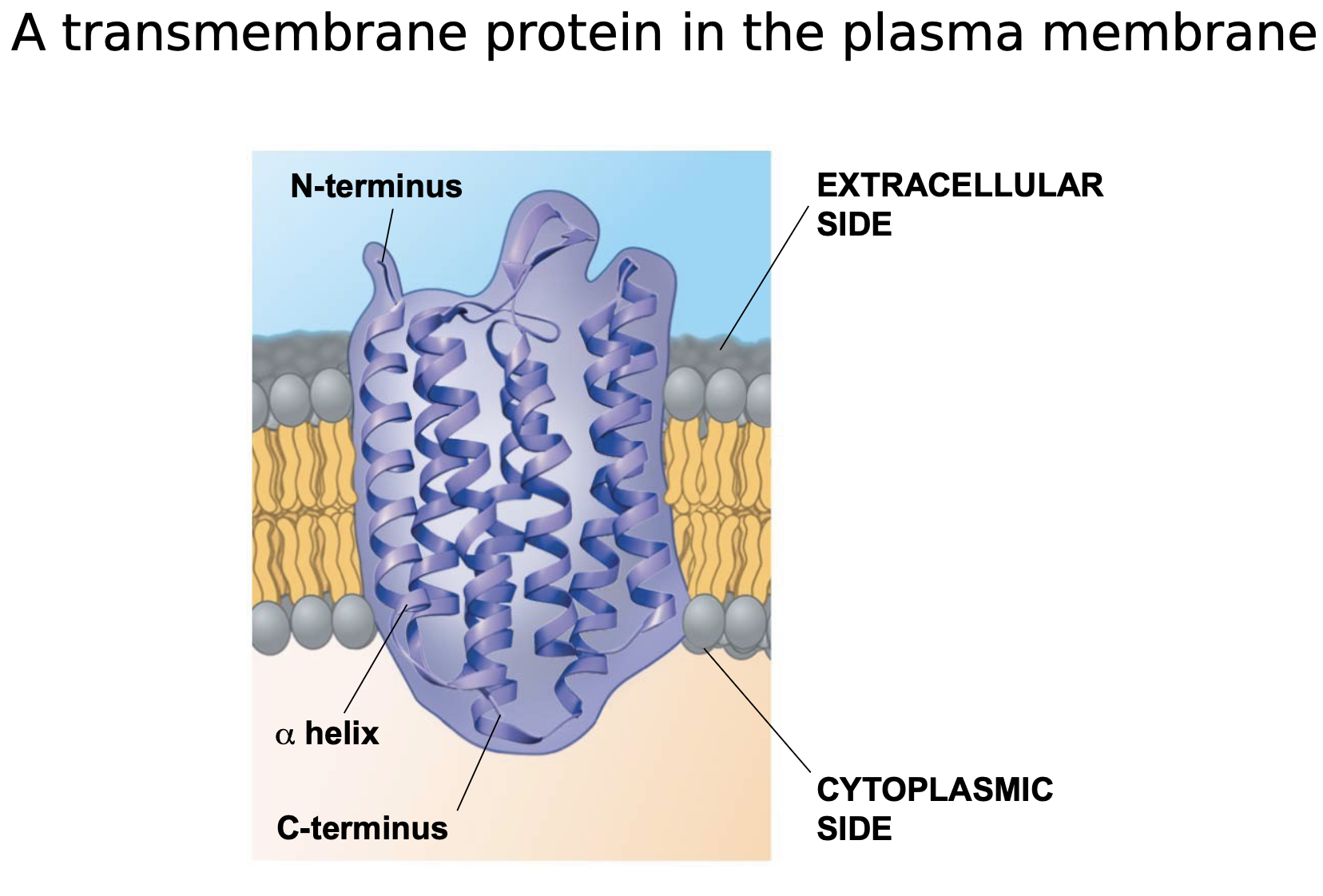
37
New cards
Six major functions of membrane proteins
\n 1. Transport - moving impermeable substances across the membrane \n 2.Enzymatic activity - catalysis of biochemical reactions \n 3.Signal transduction - receiving a signal from outside the cell \n and causing a change inside the cell in response \n 4.Cell-cell recognition - for example, glycoproteins are used by \n white blood cells to recognize self from non-self (potential pathogens) \n 5.Intercellular joining - long-lasting binding that holds cells and tissues together \n 6.Attachment to the cytoskeleton and extracellular matrix (ECM) - also holds together cells and larger cellular structures
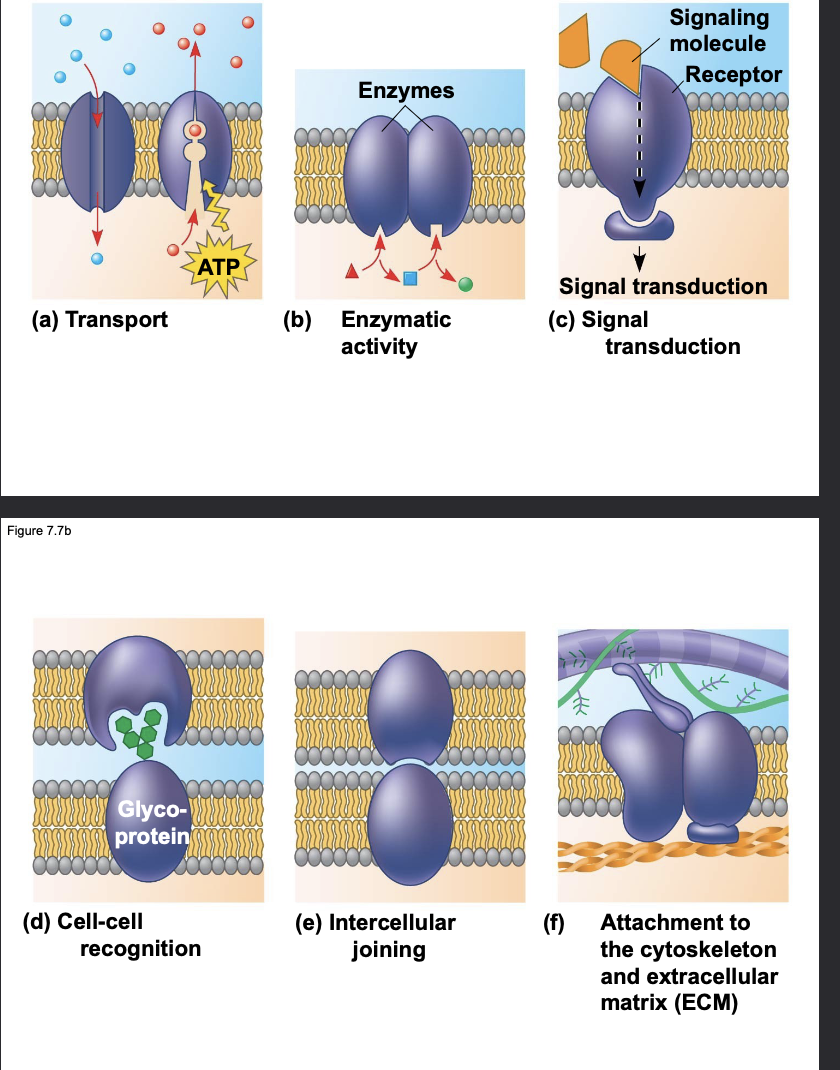
38
New cards
The Role of Membrane Carbohydrates in Cell- Cell Recognition
.Cells recognize each other by binding to molecules, often containing carbohydrates, on the extracellular surface of the plasma membrane \n .Membrane carbohydrates may be covalently bonded to lipids (forming glycolipids) or more commonly to proteins (forming glycoproteins) \n ▪.Carbohydrates on the external side of the plasma membrane vary among species, individuals, and even cell types in an individual
39
New cards
Synthesis and "Sidedness" of Membranes
\n .Membranes have distinct inside and outside faces \n .The asymmetrical distribution of proteins, lipids, and associated carbohydrates in the plasma membrane is determined when the membrane is built by the ER and Golgi apparatus
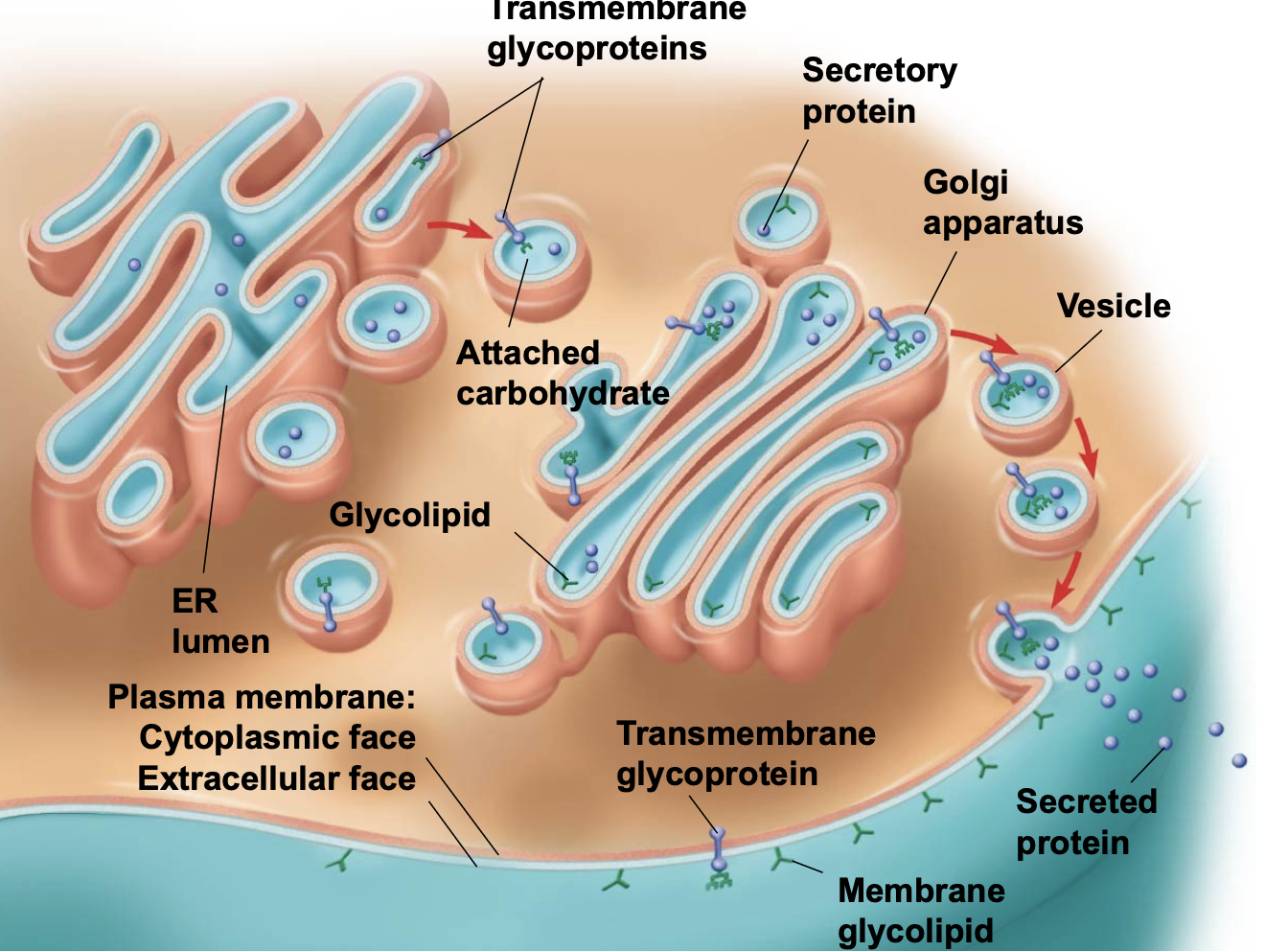
40
New cards
diffusion
.Diffusion is the tendency for molecules to spread out evenly into the available space \n .Although each molecule moves randomly, diffusion of a population of molecules may be directional \n .At dynamic equilibrium, as many molecules cross the membrane in one direction as in the other
.Substances diffuse down their concentration gradient, the region along which the density of a chemical substance increases or decreases \n .No work must be done to move substances down the concentration gradient \n .The diffusion of a substance across a biological membrane is passive transport because no energy is expended by the cell to make it happen
.Substances diffuse down their concentration gradient, the region along which the density of a chemical substance increases or decreases \n .No work must be done to move substances down the concentration gradient \n .The diffusion of a substance across a biological membrane is passive transport because no energy is expended by the cell to make it happen
41
New cards
Facilitated Diffusion
In facilitated diffusion, transport proteins speed the passive movement of molecules across the plasma membrane \n .Transport proteins include channel proteins and carrier proteins
.Channel proteins provide corridors that allow a pecific molecule or ion to cross the membrane. \n • Aquaporins are channel proteins that facilitate the diffusion of water \n • Ion channels facilitate the diffusion of ions \n • Some ion channels, called gated channels, open or close in response to a stimulus \n ▪ Carrier proteins bind the molecule they transport then change their shape to move it across the membrane.
.Channel proteins provide corridors that allow a pecific molecule or ion to cross the membrane. \n • Aquaporins are channel proteins that facilitate the diffusion of water \n • Ion channels facilitate the diffusion of ions \n • Some ion channels, called gated channels, open or close in response to a stimulus \n ▪ Carrier proteins bind the molecule they transport then change their shape to move it across the membrane.

42
New cards
Effects of Osmosis on Water Balance
.Osmosis is the diffusion of water across a selectively permeable membrane \n .Water diffuses across a membrane from the region of lower solute concentration to the region of higher solute concentration until the solute concentration is equal on both sides
43
New cards
Water Balance of Cells
.Tonicity is the ability of a surrounding solution to cause a cell to gain or lose water \n .Isotonic solution: Solute concentration is the same as that inside the cell; no net water movement across the plasma membrane \n .Hypertonic solution: Solute concentration is greater than that inside the cell; cell loses water \n .Hypotonic solution: Solute concentration is less than that inside the cell; cell gains water

44
New cards
Water Balance of Cells Without Cell Walls
.Plasmolysis - shrinking of a cell due to osmosis \n .Plasmoptysis - bursting of a cell due to osmosis
45
New cards
osmoregulation
\n .Hypertonic or hypotonic environments create osmotic problems for organisms \n .Osmoregulation, the control of solute concentrations and water balance, is a necessary adaptation for life in such environments \n .The protist Paramecium, which is hypertonic to its pond water environment, has a contractile vacuole that acts as a pump to remove the excess water being driven in by osmosis.

46
New cards
Facilitated and Passive Diffusion
.Facilitated diffusion is passive diffusion because the solute moves down its concentration gradient, and the transport requires no energy \n .Some transport proteins, however, can move solutes against their concentration gradients

47
New cards
The Need for Energy in Active Transport
.Active transport can move substances against their concentration gradients \n .Active transport is performed by specific proteins embedded in the membranes \n .Active transport requires energy, usually in the form of ATP \n .Other forms of energy can also be used to drive active transport such as Membrane potential.
48
New cards
electrogenic pump and proton pump
.An electrogenic pump is a transport protein that generates voltage across a membrane \n .The sodium-potassium pump is the major electrogenic pump of animal cells \n .The main electrogenic pump of plants, fungi, and bacteria is a proton pump \n .Electrogenic pumps help store energy that can be used for cellular work
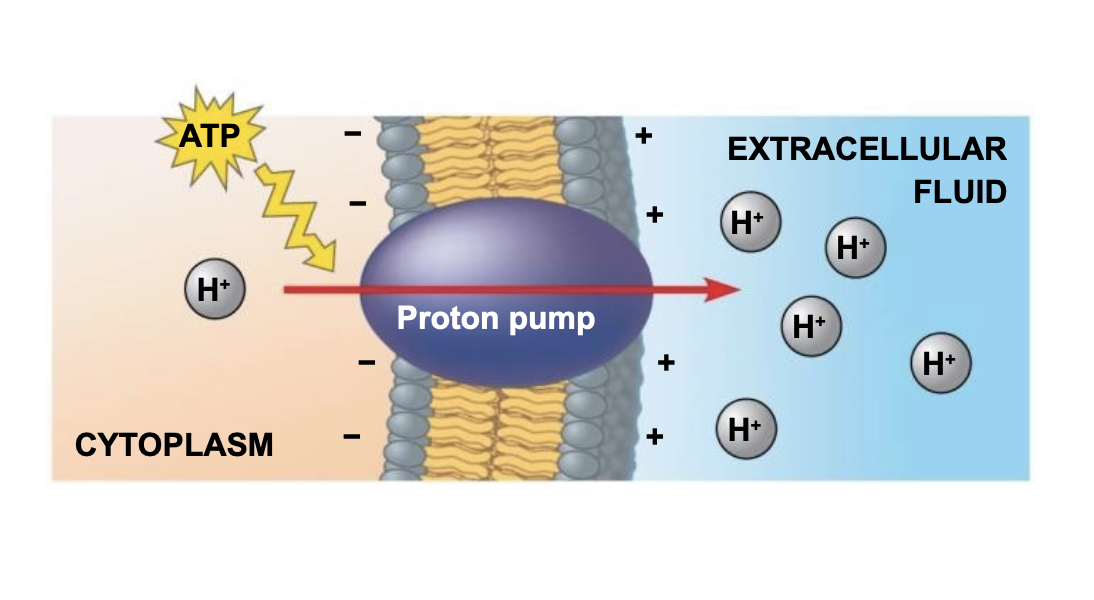
49
New cards
Coupled Transport by a Membrane Protein
.Cotransport occurs when active transport of a solute indirectly drives transport of other substances \n In these cases, one transport protein creates a gradient, then the potential energy stored in that gradient is used transport a different molecule with a second transport protein. \n .Plants commonly use the gradient of hydrogen ions generated by proton pumps to drive active transport of nutrients into the cell
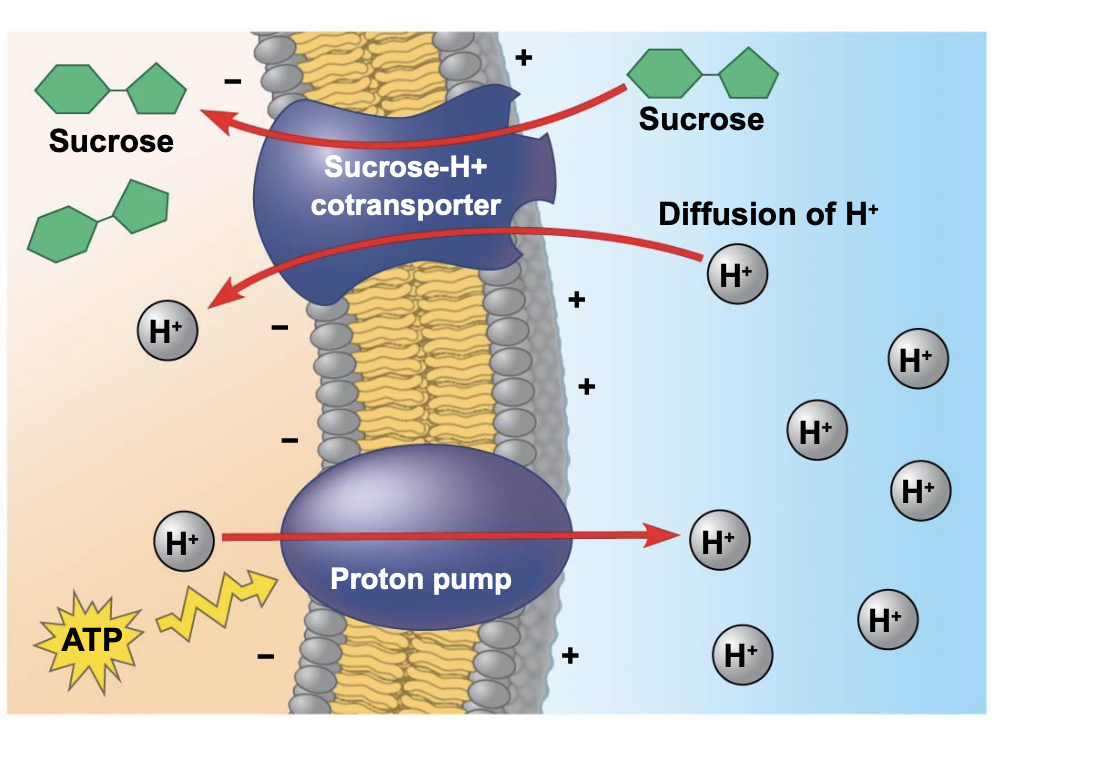
50
New cards
Bulk transport
.Bulk transport across the plasma membrane occurs by exocytosis and endocytosis
.Small molecules and water enter or leave the cell through the lipid bilayer or via transport proteins \n .Large molecules, such as polysaccharides and proteins, cross the membrane in bulk via vesicles \n .Bulk transport requires energy
.Small molecules and water enter or leave the cell through the lipid bilayer or via transport proteins \n .Large molecules, such as polysaccharides and proteins, cross the membrane in bulk via vesicles \n .Bulk transport requires energy
51
New cards
Exocytosis
In exocytosis, transport vesicles migrate to the membrane, fuse with it, and release their contents outside the cell
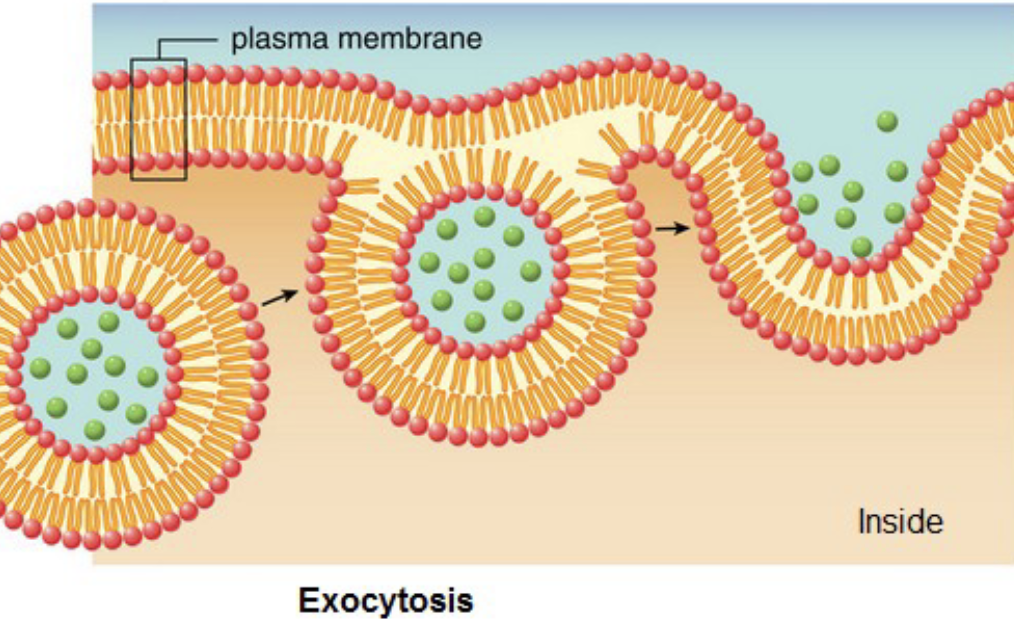
52
New cards
Endocytosis
In endocytosis, the cell takes in macromolecules by forming vesicles from the plasma membrane \n .Endocytosis is a reversal of exocytosis, involving different proteins \n .There are three types of endocytosis: \n .Phagocytosis. The vacuole fuses with a lysosome to digest the particle \n .Pinocytosis-molecules dissolved in droplets are taken up when extracellular fluid is “gulped” into tiny vesicle \n .Receptor-mediated endocytosis-binding of molecules to receptor proteins triggers vesicle formation
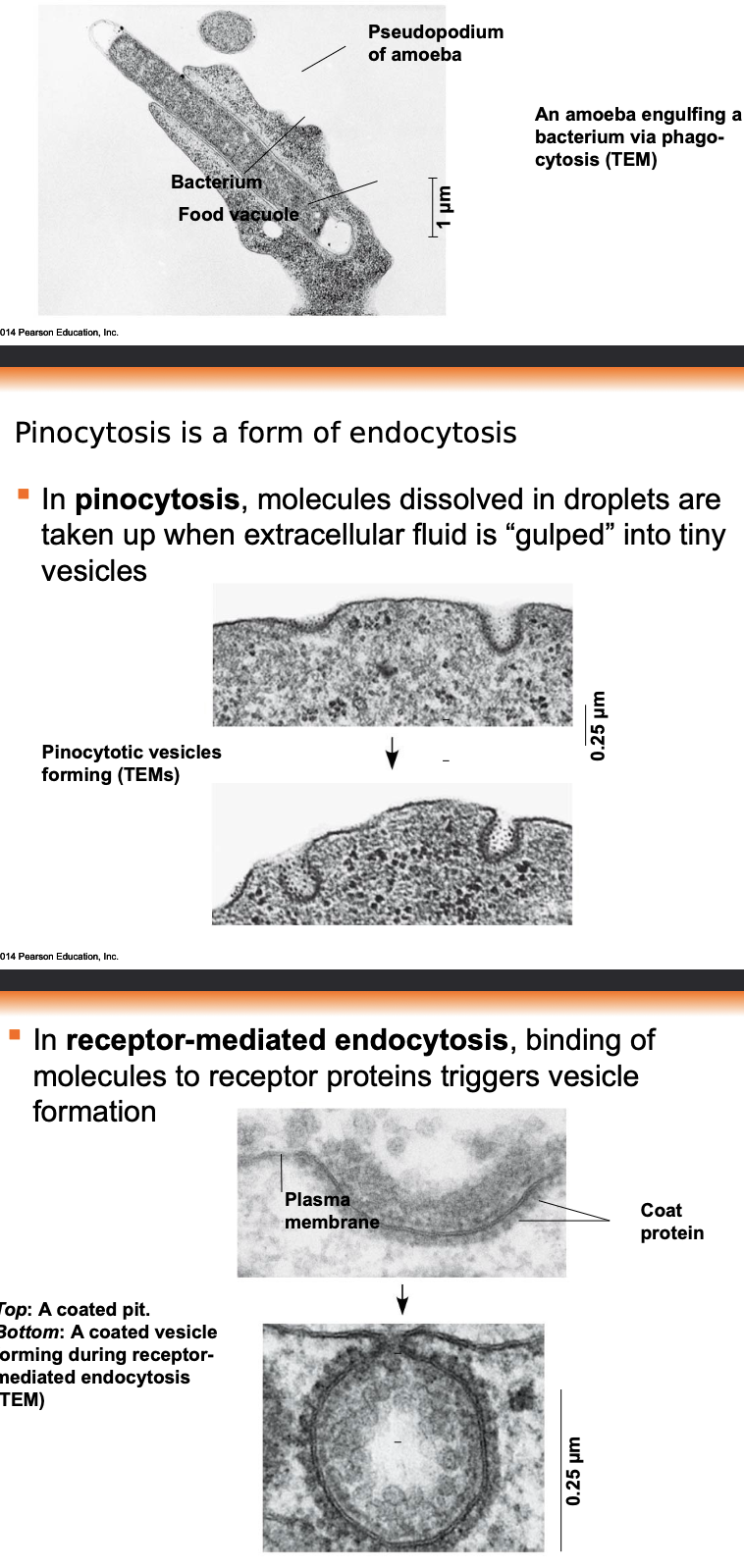
53
New cards
Cellular Messaging
.Cells can signal to each other and interpret the signals they receive from other cells and the environment \n .Signals are typically small molecules or small proteins \n .Cellular signaling allows for response to the environment and coordination of cellular functions in multicellular animals.
54
New cards
Local Signaling
.Cells in a multicellular organism communicate via signaling molecules \n .In local signaling, animal cells may communicate by direct contact \n .A receptor on one cell binds a molecule on an adjacent cell \n .Animal and plant cells have cell junctions that directly connect the cytoplasm of adjacent cells (gap junctions in animals; plasmodesmata in plants) \n .Signaling molecules in the cytosol can pass freely between adjacent cells
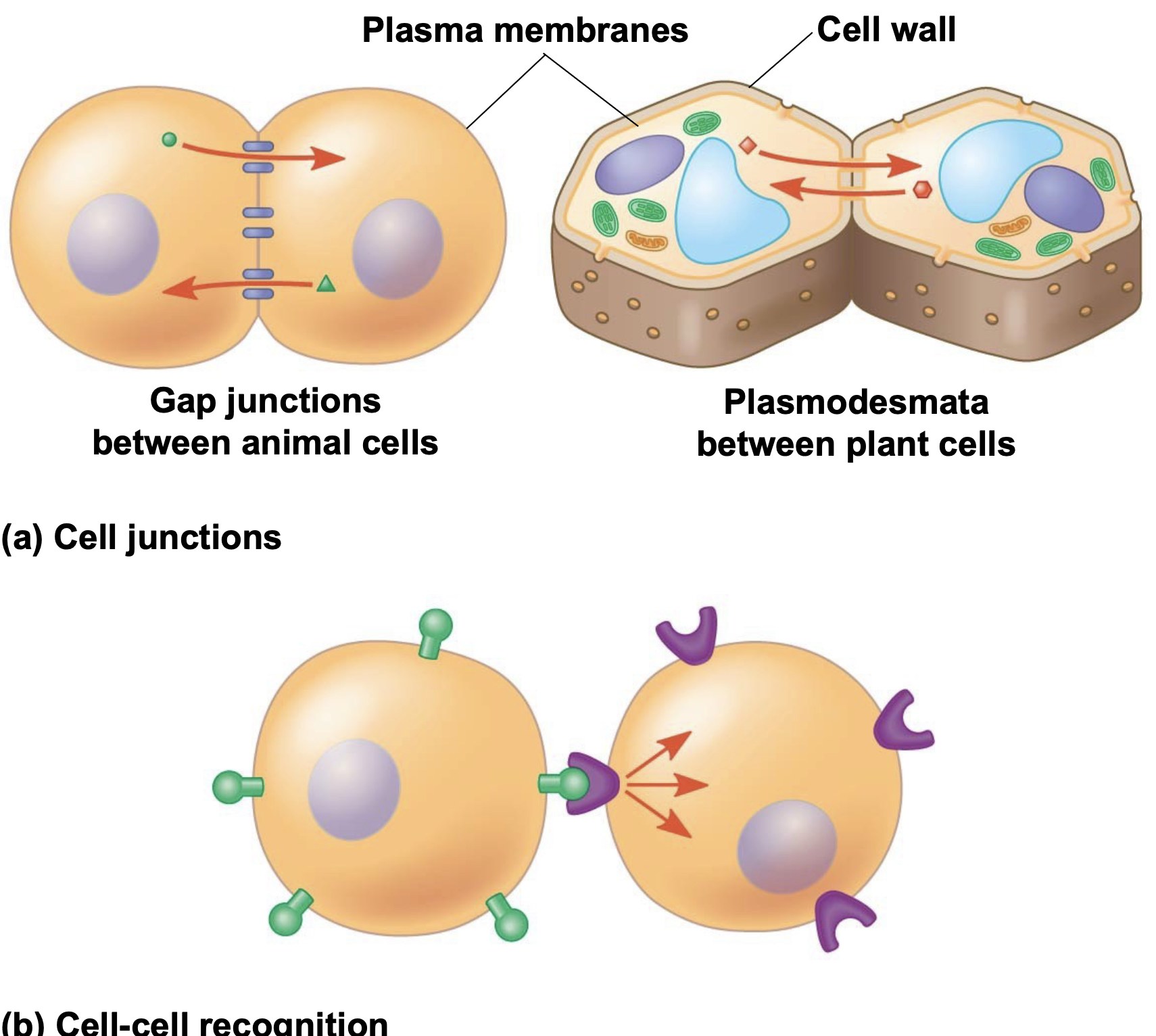
55
New cards
Paracrine signaling: local signaling by secreted molecules
.In paracrine signaling, cells communicate using secreted messenger molecules that travel only short distances to communicate with neighboring cells. \n .Growth factors, which stimulate nearby target cells to grow and divide, are one class of such local regulators in animals
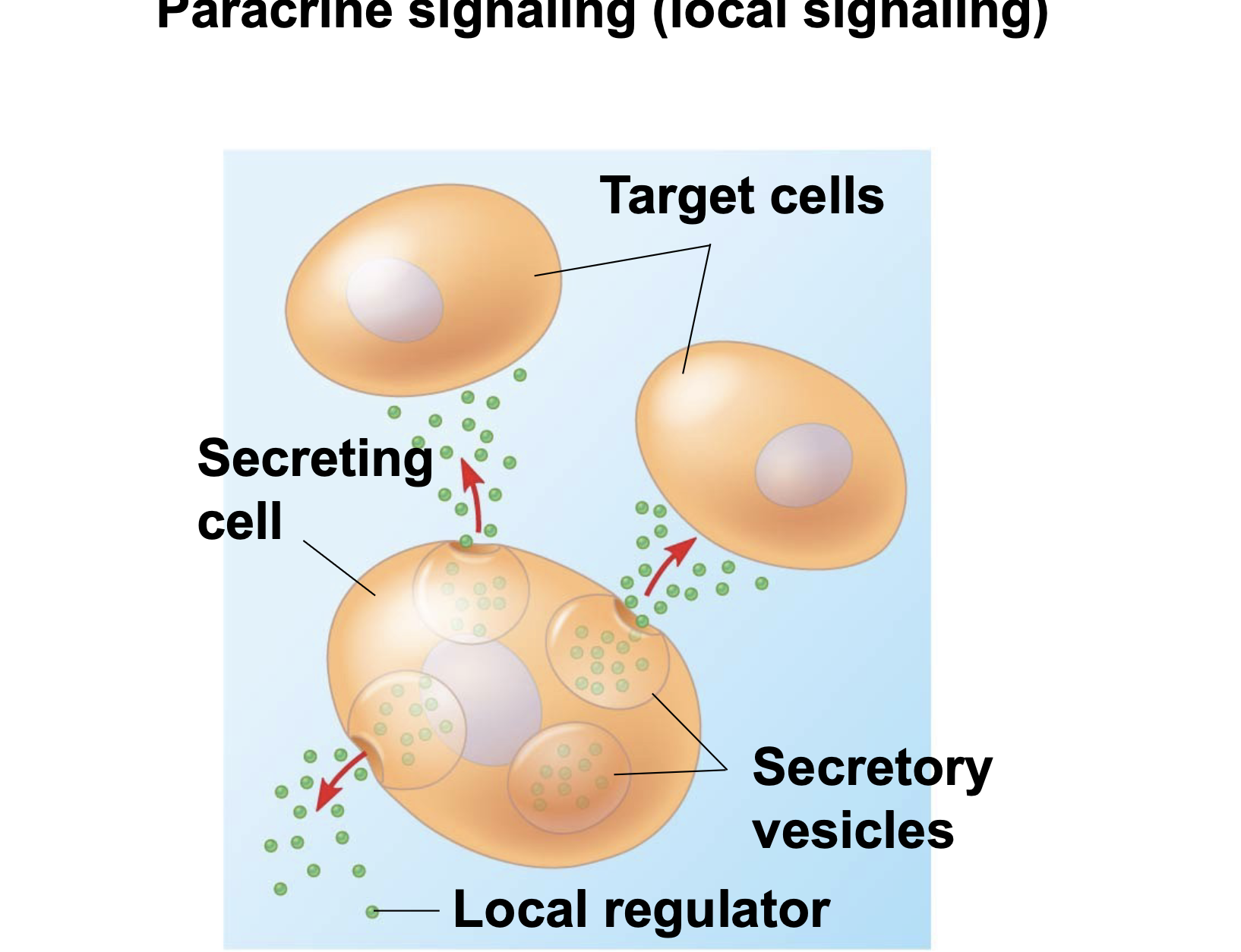
56
New cards
Synaptic signaling: local signaling between nerve cells
. synapse is a gap between nerve cells. \n .Synaptic signaling transmits a signal from one nerve cell to the next through the synapse. \n .A signaling molecule called a neurotransmitter is released by one nerve cell into a synapse. The neurotransmitter crosses the synapse and binds to receptors on the neighboring nerve cell.
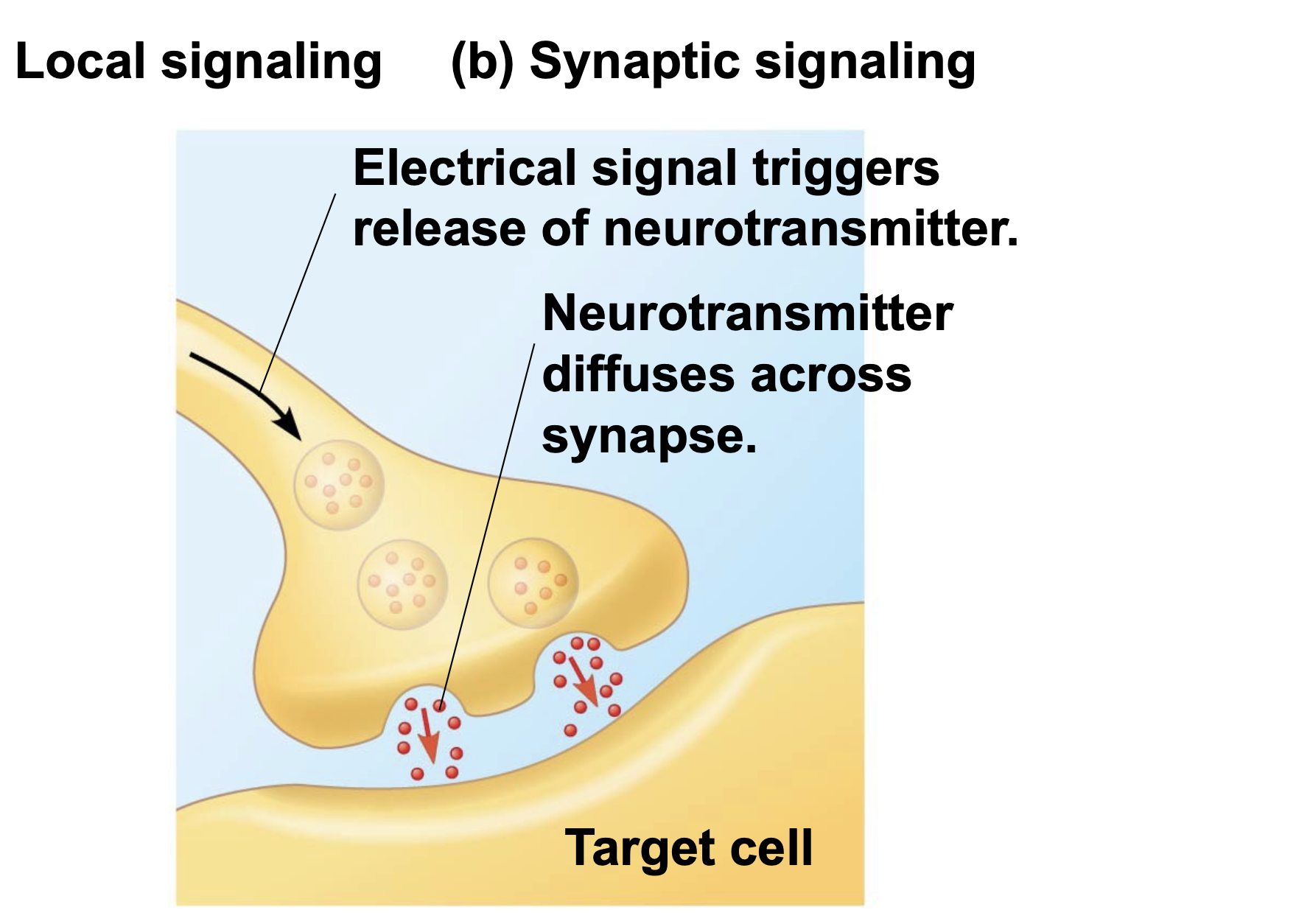
57
New cards
Endocrine signaling: long distance signaling using hormones
.In long-distance signaling, plants and animals use \n chemicals called hormones \n .Hormonal signaling is called endocrine signaling; specialized cells release hormones, which travel to target cells via the circulatory system \n .The ability of a cell to respond to a signal depends on whether or not it has a receptor specific to that signal
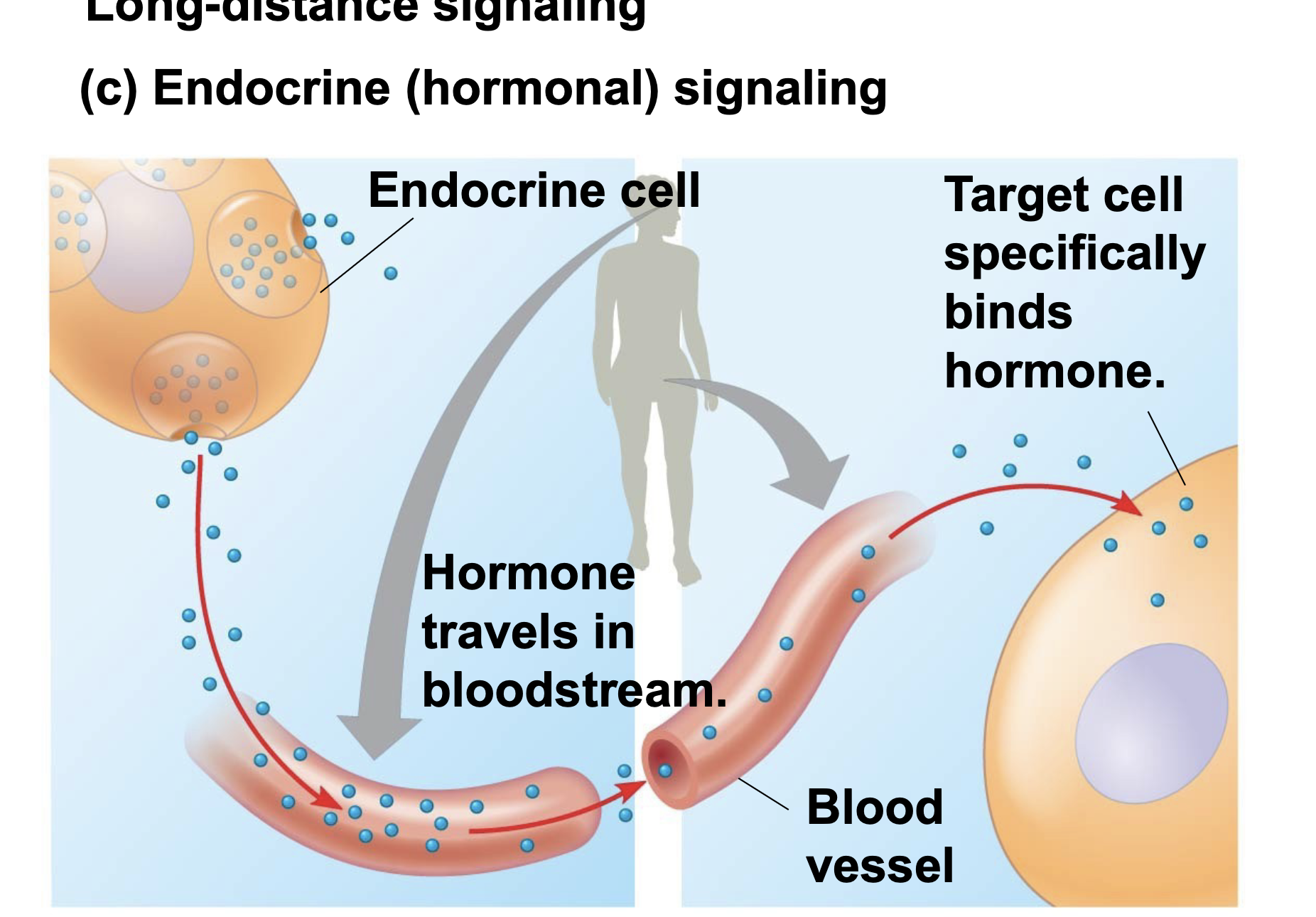
58
New cards
The Three Stages of Cell Signaling:
.Earl W. Sutherland at Vanderbilt University discovered cAMP and how the hormone epinephrine (also called adrenaline) acts on cells \n .Sutherland won the 1971 Nobel Prize in Physiology or Medicine for this work \n .Sutherland suggested that cells receiving signals went through three processes \n 1.Reception-the target cell detects a signaling molecule that binds to a receptor protein on the cell surface \n 2.Transduction-the binding of the signaling molecule alters the receptor and initiates a signal transduction pathway that transfers the signal into the inside of the cell; transduction often occurs in a series of steps \n 3.Response-the transduced signal triggers a specific response in the target cell
.In many (but not all) transduction pathways, the relay molecules are enzymes called kinases which pass along the signal by adding a phosphate group to the next protein in the transduction chain.
.In many (but not all) transduction pathways, the relay molecules are enzymes called kinases which pass along the signal by adding a phosphate group to the next protein in the transduction chain.

59
New cards
Reception
Reception: A signaling molecule binds to a receptor protein, causing it to change shape \n .The binding between a signal molecule (ligand) and receptor is highly specific \n .A shape change in a receptor is often the initial transduction of the signal \n .Most signal receptors are plasma membrane proteins
60
New cards
There are three main types of membrane receptors
1\.G protein-coupled receptors \n 2.Receptor tyrosine kinases \n 3.Ion channel receptors
61
New cards
G protein-coupled receptors (GPCRs)
cell surface transmembrane receptors that work with the help of a G protein
The receptor activates a G protein that in turn activates enzymes to cause a cellular response
The receptor activates a G protein that in turn activates enzymes to cause a cellular response

62
New cards
Receptor tyrosine kinases (RTKs)
A kinase is an enzyme that attaches a phosphate group to another protein. \n .Receptor tyrosine kinases (RTKs) are membrane receptors that attach phosphates to the amino acid tyrosine in a protein \n .A receptor tyrosine kinase can trigger multiple signal transduction pathways at once by phosphorylating multiple proteins in multiple pathways
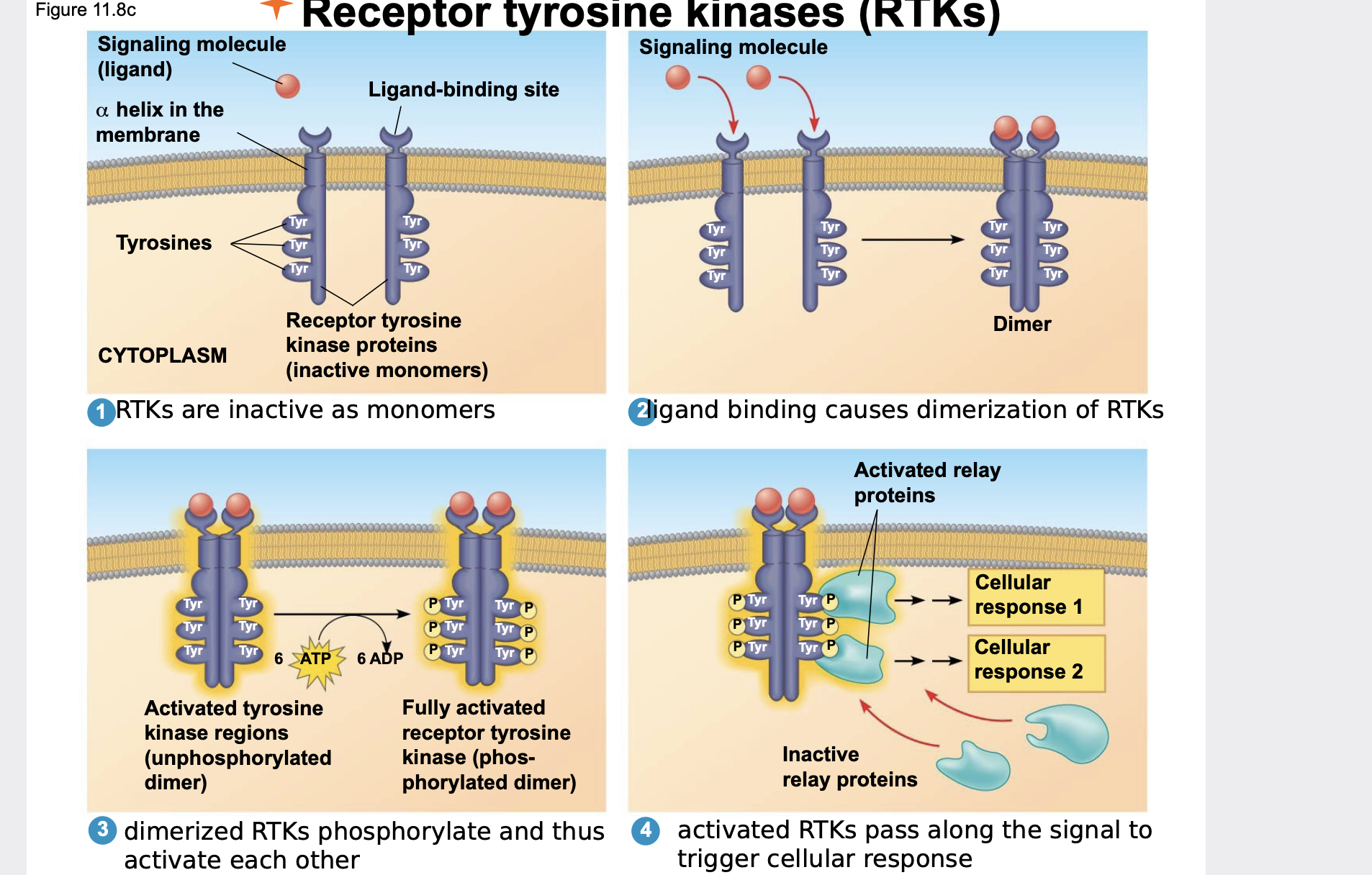
63
New cards
ligand-gated ion channel
A the molecule that is bound by a receptor is called its ligand. \n .A ligand-gated ion channel is a transmembrane protein that allows ions to pass through when it binds a signaling molecule (ligand). \n .When a a ligand-gated ion channel binds its ligand it opens like a gate to allow specific ions (such as Na+ or Ca2+) to pass across the membrane through a channel in the receptor \n .These ions then trigger a response in the cell
1. Ligand binding causes the ion channel to open
2. Ions enter thecell and trigger a cellular response.
3. The channel closes when theligand is no longer bound.
1. Ligand binding causes the ion channel to open
2. Ions enter thecell and trigger a cellular response.
3. The channel closes when theligand is no longer bound.
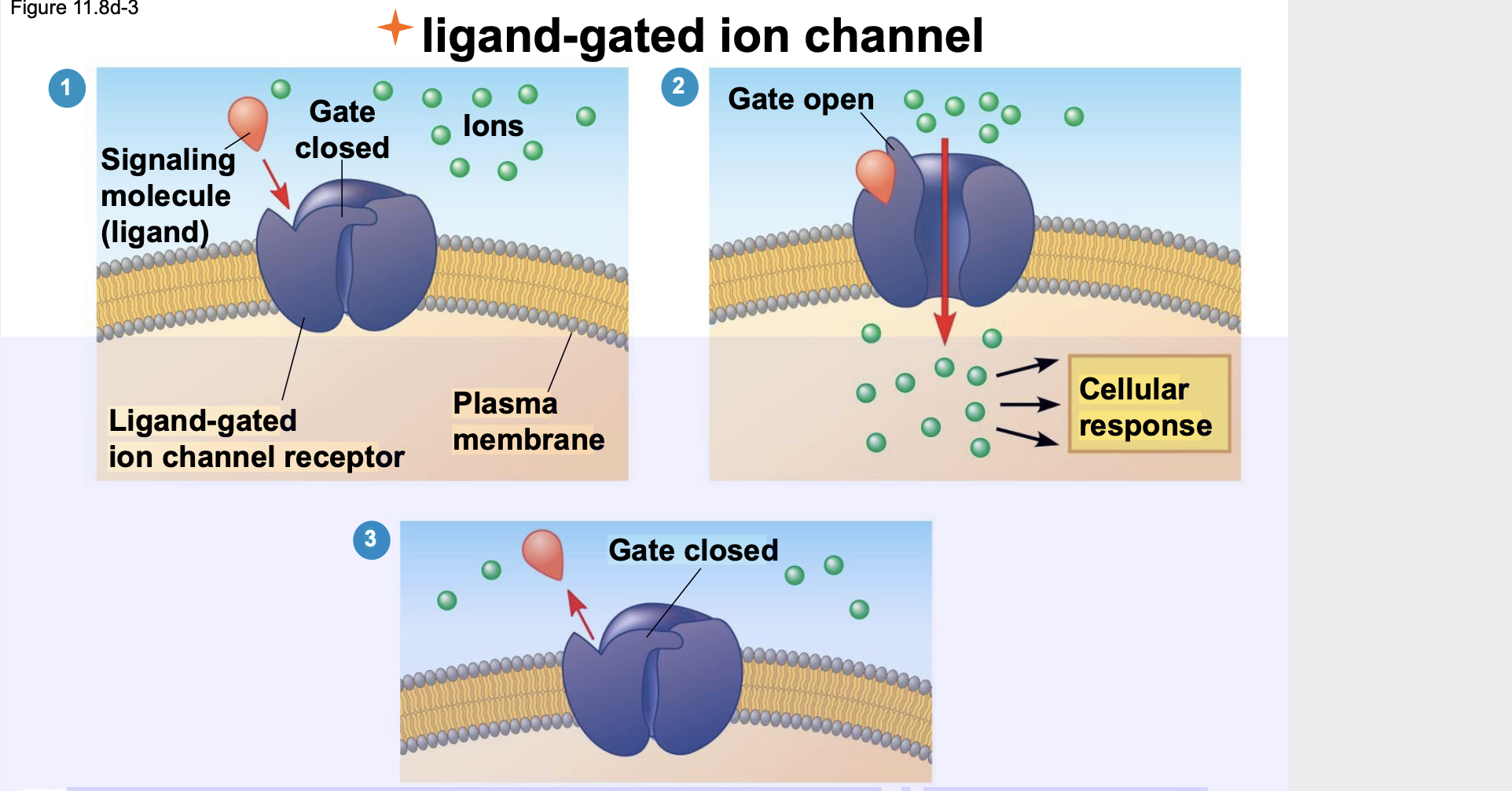
64
New cards
Intracellular Receptors
(Inside the cell, NOT on the plasma membrane) \n .Intracellular receptor proteins are found in the cytoplasm or nucleus of target cells \n .Small, hydrophobic chemical messengers can readily cross the plasma membrane and activate intracellular receptors \n .Examples of hydrophobic messengers are the steroid hormones of animals. An activated steroid hormone-receptor complex can \n act as a transcription factor, turning on specific genes
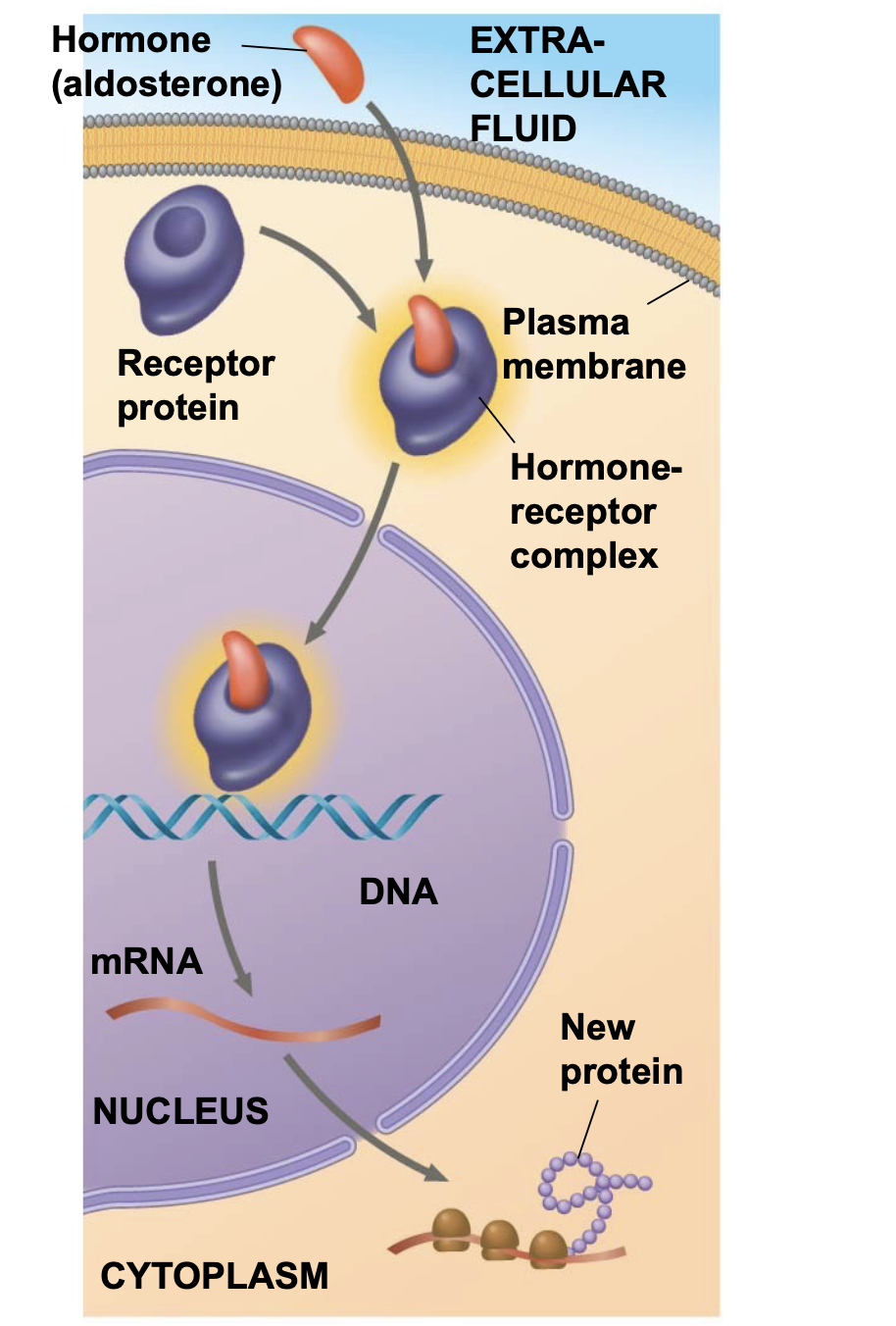
65
New cards
\n Transduction
Signals are relayed from receptors to target molecules in the cell \n .Signal transduction usually involves multiple steps \n .Like falling dominoes, the receptor activates another protein, which activates another, and so on, until the protein producing the cellular response is activated \n .At each step, the signal is transduced into a different form, often a modification of a protein (such as phosphorylation) \n .Multistep pathways can greatly amplify a signal \n .Multistep pathways provide more opportunities for coordination and regulation of the cellular respons
66
New cards
Signal Transduction Pathways
After a receptor binds its ligand it triggers the first step in a chain of molecular interactions to carry (transduce) the signal inside the cell \n .Like falling dominoes, the receptor activates another protein, which activates another, and so on, until the protein producing the cellular response is activated \n .At each step, the signal is transduced into a different form, often a modification of a protein (such as phosphorylation)
67
New cards
Signal transduction pathway: Protein Phosphorylation and Dephosphorylation
Phosphorylation (adding a phosphate) and dephosphorylation (removing a phosphate) of proteins is a widespread cellular mechanism for regulating protein activity \n .Protein kinases transfer phosphates from ATP to protein, a process called phosphorylation \n .Many relay molecules in signal transduction pathways are protein kinases, creating a phosphorylation cascade
.Protein phosphatases remove the phosphates from proteins, a process called dephosphorylation \n .This phosphorylation and dephosphorylation system acts as a molecular switch, turning activities on and off, as required
.Protein phosphatases remove the phosphates from proteins, a process called dephosphorylation \n .This phosphorylation and dephosphorylation system acts as a molecular switch, turning activities on and off, as required
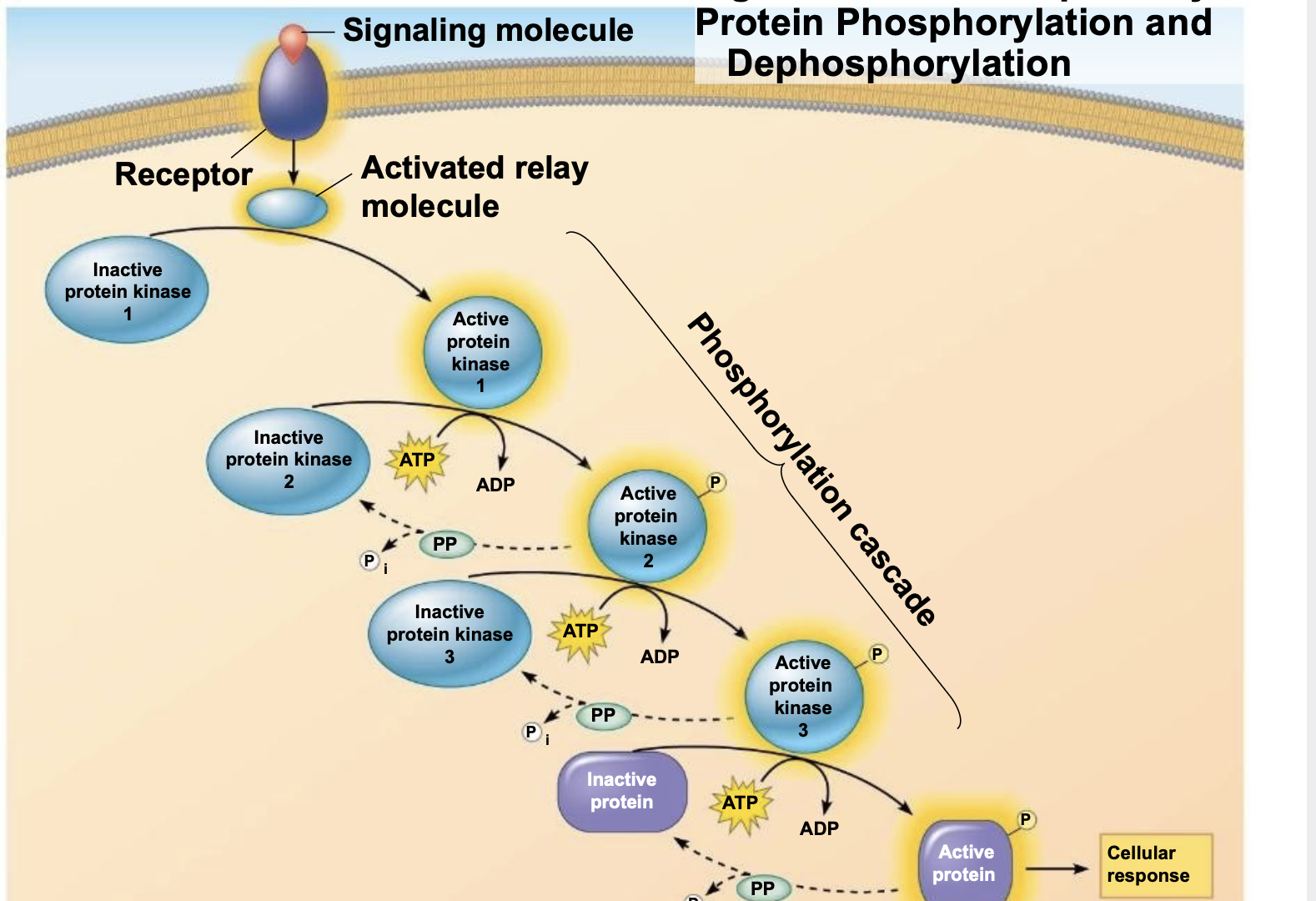
68
New cards
Small Molecules and Ions as Second Messengers
.Many signaling pathways involve second messengers \n .Second messengers are small, nonprotein molecules that spread throughout a cell by diffusion \n .Second messengers participate in pathways initiated by G-protein coupled receptors and tyrosine kinase receptors \n .Cyclic AMP (cAMP) and calcium ions are common second messengers
69
New cards
Cyclic AMP
.Cyclic AMP (cAMP) is one of the most widely used second messengers \n .Adenylyl cyclase, an enzyme in the plasma membrane, converts ATP to cAMP in response to an extracellular signal
.cAMP usually activates a kinase called protein kinase A, which then phosphorylates various other proteins
.cAMP usually activates a kinase called protein kinase A, which then phosphorylates various other proteins
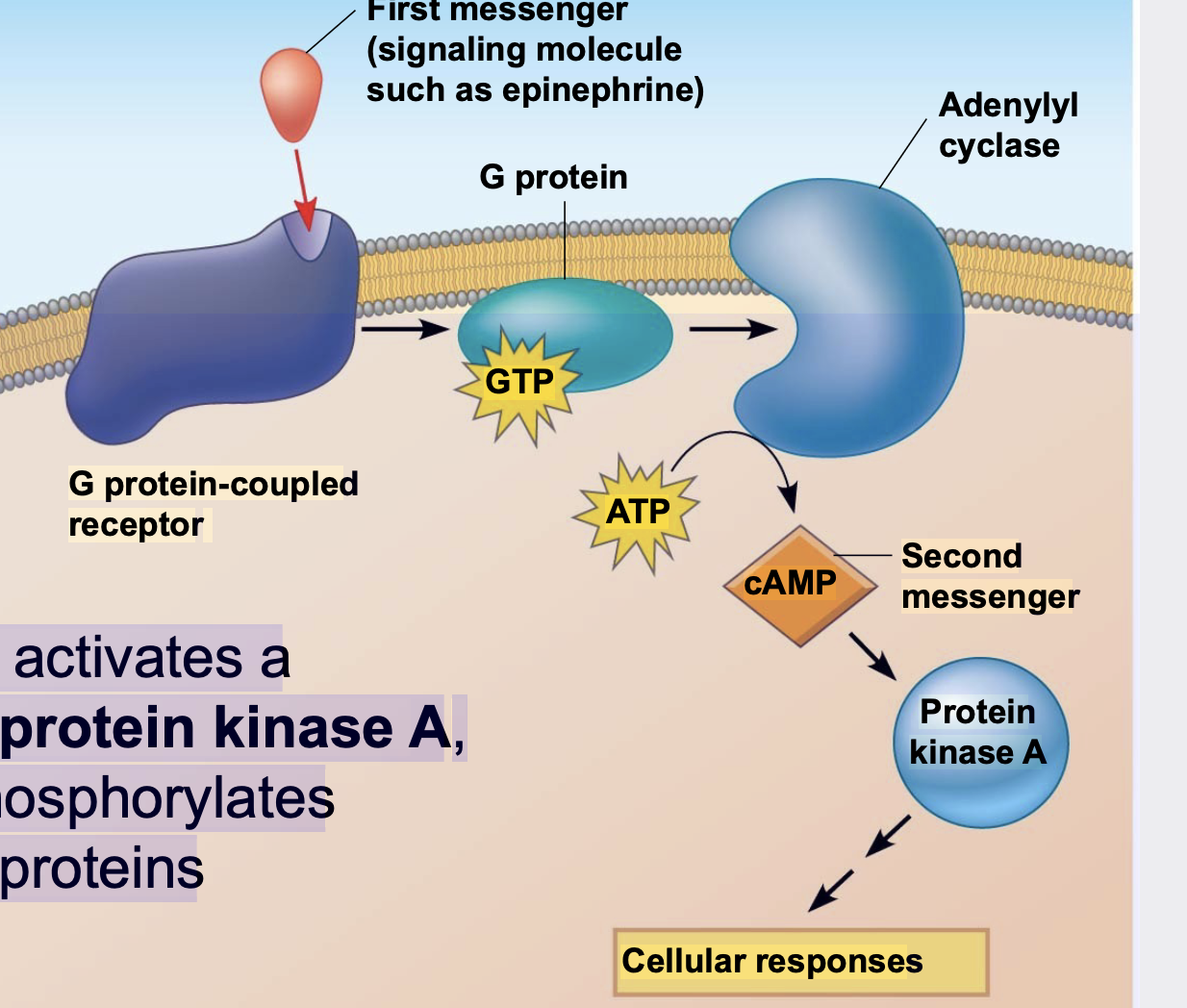
70
New cards
Signal Amplification During Transduction
Enzyme cascades amplify the cell’s response to a signal \n .At each step in a signal transduction cascade, the number of activated products is much greater than in the preceding step
\n
\n
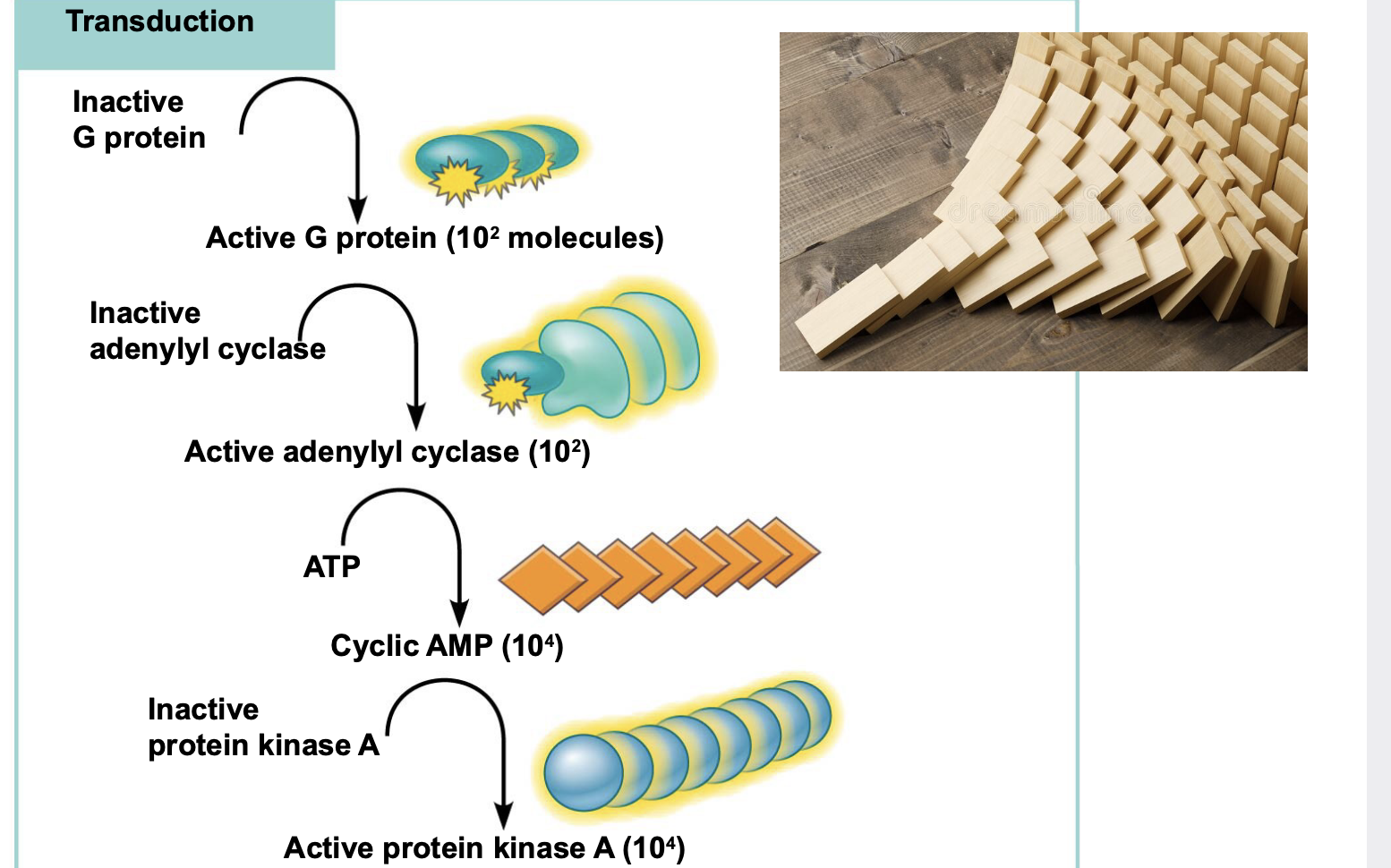
71
New cards
Response:Cell signaling leads to regulation of transcription or cytoplasmic activities
\n .The cell’s response to an extracellular signal involves changes in gene expression (by changing transcription) and/or changes in cytoplasmic enzyme activity.
.Nuclear Responses to a Signal: The Activation of a Specific Gene by a Growth Factor.
.The same signaling molecule (red) can have different responses in different cells, depending on the types of signaling pathways present in the cell.
.Nuclear Responses to a Signal: The Activation of a Specific Gene by a Growth Factor.
.The same signaling molecule (red) can have different responses in different cells, depending on the types of signaling pathways present in the cell.
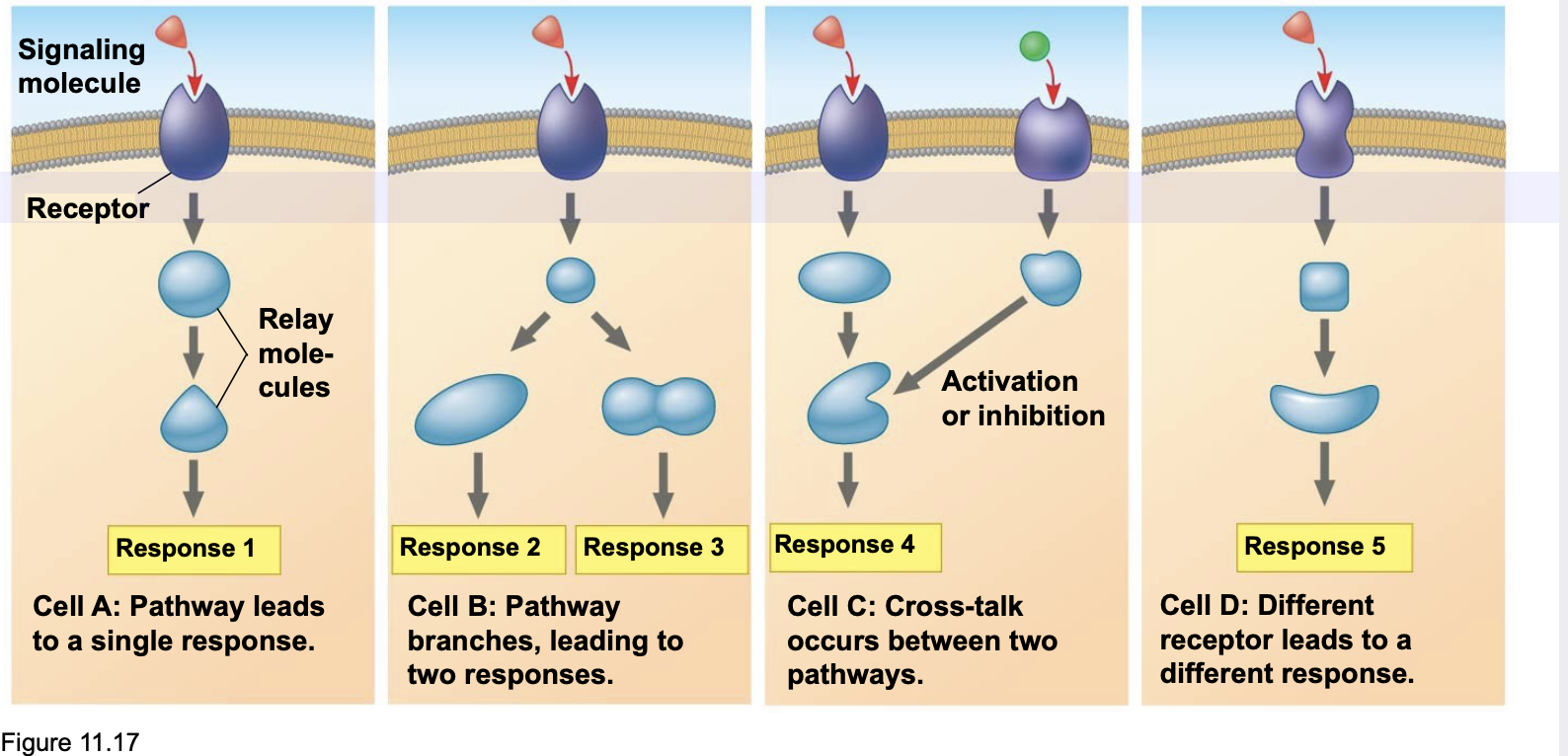
72
New cards
Termination of the Signal
.Once a cell has made its response to a signal, it then needs a way to turn the signal off. \n .If ligand concentration falls, fewer receptors will be bound \n .Dephosphorylation can turn off a kinase cascade \n .Ions that act as second messengers are pumped back where they came from \n .cAMP is broken down to AMP
73
New cards
Signaling Triggers Nuclear and Cytoplasmic Responses
Ultimately, a signal transduction pathway leads to regulation of one or more cellular activities \n .The response to a signal may occur in the cytoplasm (by activating or inactivating an enzyme) or in the nucleus (by changing gene expression) or a combination of both (if the signal is transduced to both).
74
New cards
CELLULAR RESPIRATION: AEROBIC HARVEST OF FOOD ENERGY
.During cellular respiration, food molecules are broken down to form carbon dioxide (that we exhale as waste). The energy that was stored in the food is released as the food is broken down, and the released energy is transferred into the energy stored by ATP. \n .This is not accomplished in a single chemical reaction. Instead it is a series of very complex biochemical steps. \n .Respiration is an aerobic process. Aerobic means that it requires oxygen. We will see that the last step is the oxygen-requiring step.
In cellular respiration, glucose and oxygen are consumed and carbon dioxide and water are produced as the energy from glucose is transferred to ATP. However, this equation does not describe the actual chemistry that occurs. \n .Respiration takes place through a series of processes that involve oxidation-reduction reactions that ultimately transfers the energy in glucose to ATP. We will see that during these processes, the glucose in converted to carbon dioxide, and the \n oxygen is converted to water.
In cellular respiration, glucose and oxygen are consumed and carbon dioxide and water are produced as the energy from glucose is transferred to ATP. However, this equation does not describe the actual chemistry that occurs. \n .Respiration takes place through a series of processes that involve oxidation-reduction reactions that ultimately transfers the energy in glucose to ATP. We will see that during these processes, the glucose in converted to carbon dioxide, and the \n oxygen is converted to water.

75
New cards
Redox Reactions: Oxidation and Reduction
Chemical reactions that transfer electrons between reactants are called oxidation-reduction reactions, or redox reactions \n .In oxidation, a substance loses electrons, or is oxidized \n .In reduction, a substance gains electrons, or is reduced (the amount of positive charge is reduced) \n .Electrons carry energy, so redox reactions are used in respiration to transfer energy from one molecule to another.
.Controlled redox reactions allow for careful and efficient energy transfer through the transfer of electrons.
.Controlled redox reactions allow for careful and efficient energy transfer through the transfer of electrons.
76
New cards
Oxidation-reduction reactions
oxidation is when an atom or molecule loses an electron \n . reduction is when an atom or molecule gains an electron \n .when an electron in lost in oxidation, a hydrogen is often lost with it \n . likewise, when an electron is gained in reduction, a hydrogen is gained with it
.In cellular respiration, glucose is oxidized and oxygen is reduced.
.In cellular respiration, glucose is oxidized and oxygen is reduced.
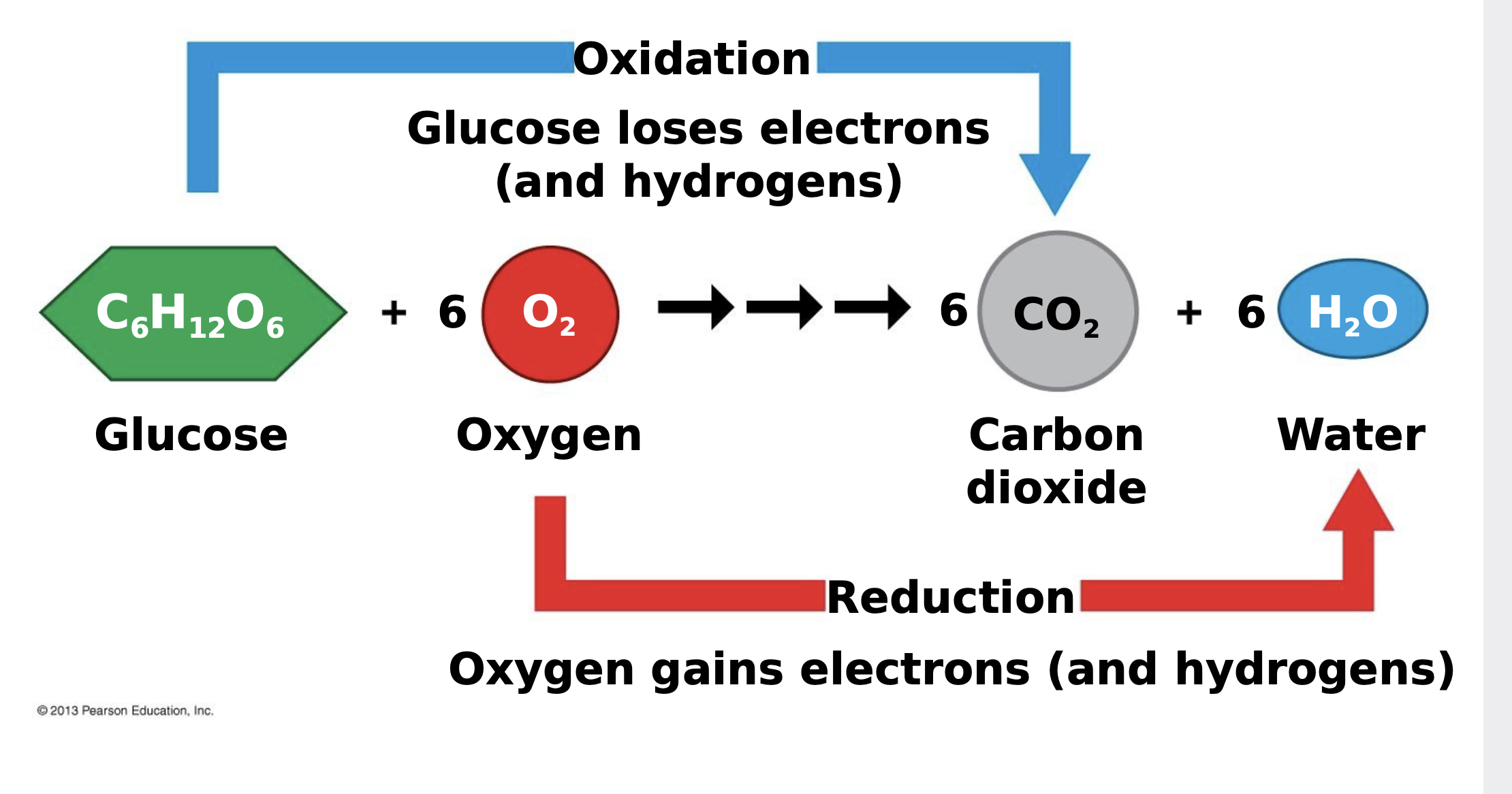
77
New cards
Cellular respiration takes place in three main stages:
1. Glycolysis
2. Krebs cycle (citric acid cycle)
3. Electron transport chain (oxidative phosphorylation)
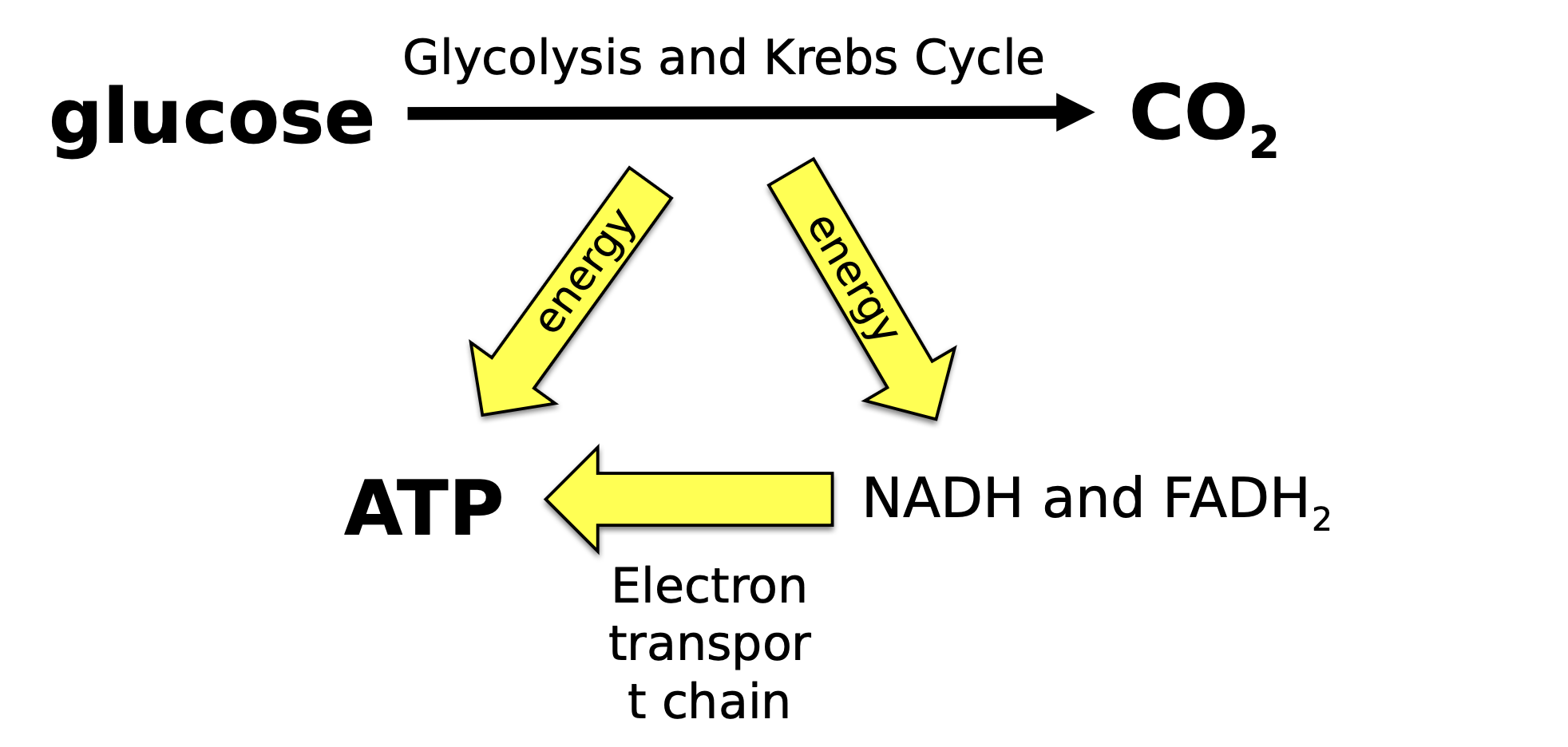
78
New cards
Glycolysis
.begins the breakdown of glucose by redox reactions; performed by enzymes in the cytoplasm
.A six-carbon glucose molecule is split in half to form two molecules of pyruvate (a 3-carbon molecule). \n • This process involves a series of 10 different enzymes. \n • Two molecules of ATP are used in glycolysis, but four molecules of ATP are produced, for a net gain of two ATP.
Glycolysis harvests chemical \n energy by oxidizing glucose to pyruvate \n .Glycolysis breaks down glucose into two molecules of pyruvate \n .Glycolysis occurs in the cytoplasm and has two major phases \n .Energy investment phase (which requires 5 enzymes and uses 2 ATP) \n .Energy payoff phase (which requires 5 more enzymes and produces 4 ATP) \n .Glycolysis occurs whether or not O2 is present
.A six-carbon glucose molecule is split in half to form two molecules of pyruvate (a 3-carbon molecule). \n • This process involves a series of 10 different enzymes. \n • Two molecules of ATP are used in glycolysis, but four molecules of ATP are produced, for a net gain of two ATP.
Glycolysis harvests chemical \n energy by oxidizing glucose to pyruvate \n .Glycolysis breaks down glucose into two molecules of pyruvate \n .Glycolysis occurs in the cytoplasm and has two major phases \n .Energy investment phase (which requires 5 enzymes and uses 2 ATP) \n .Energy payoff phase (which requires 5 more enzymes and produces 4 ATP) \n .Glycolysis occurs whether or not O2 is present
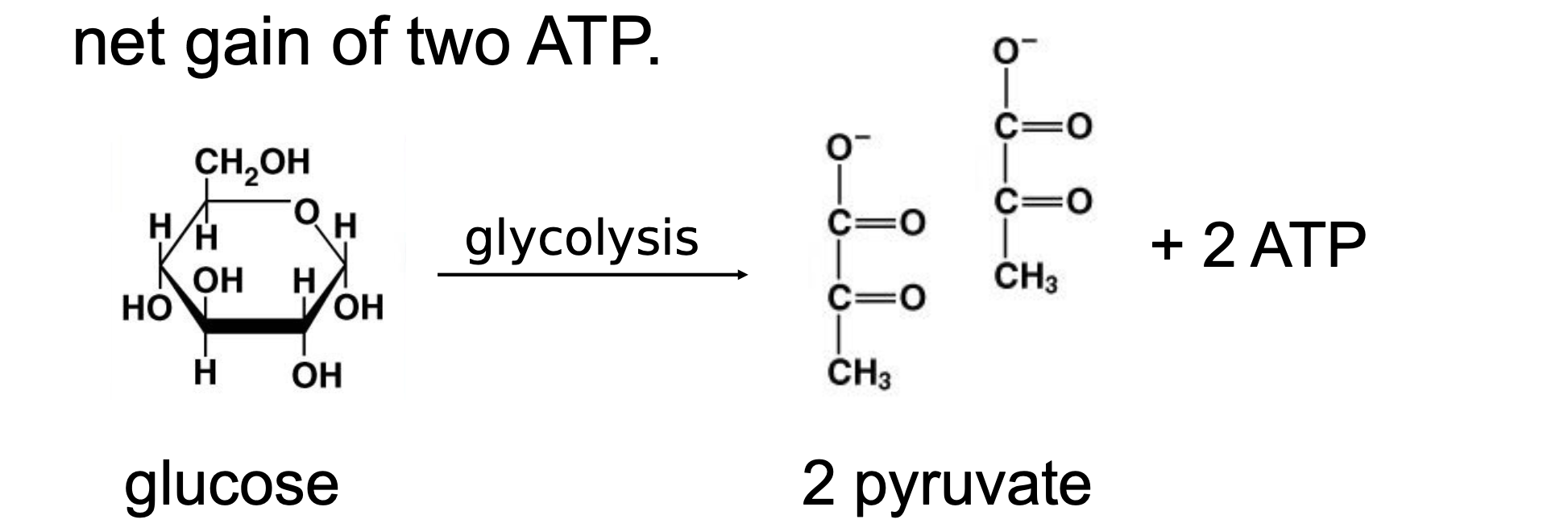
79
New cards
Glycolysis harvests chemical energy by oxidizing glucose to pyruvate
Glycolysis breaks down glucose into two molecules of pyruvate \n .Glycolysis occurs in the cytoplasm and has two major phases \n .Energy investment phase (which requires 5 enzymes and uses 2 ATP) \n .Energy payoff phase (which requires 5 more enzymes and produces 4 ATP) \n .Glycolysis occurs whether or not O2 is present
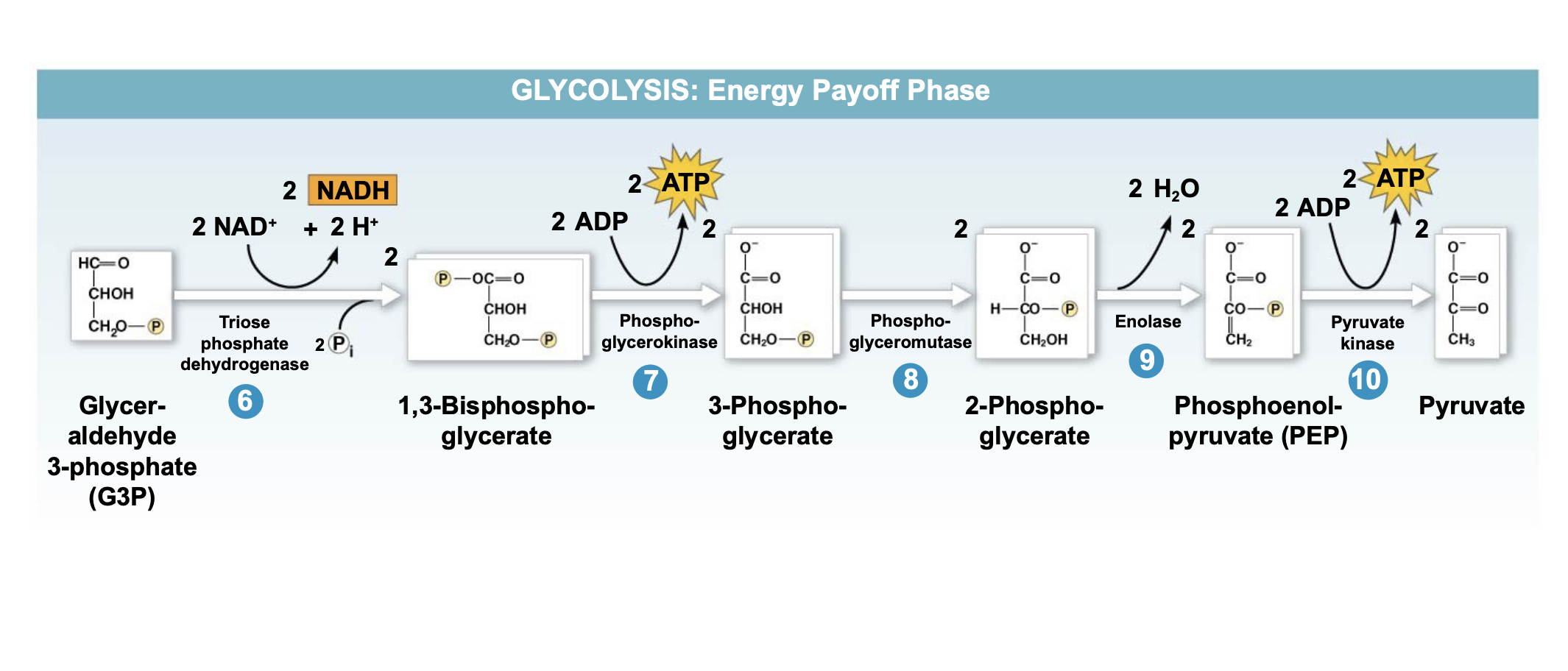
80
New cards
Oxidation of Pyruvate to Acetyl CoA
.Before the Krebs cycle (citric acid cycle) can begin, pyruvate must be converted to acetyl Coenzyme A (acetyl CoA), which feeds into the citric acid cycle \n .This step is carried out by a multienzyme complex that catalyzes three reactions and produces some CO2 and NADH
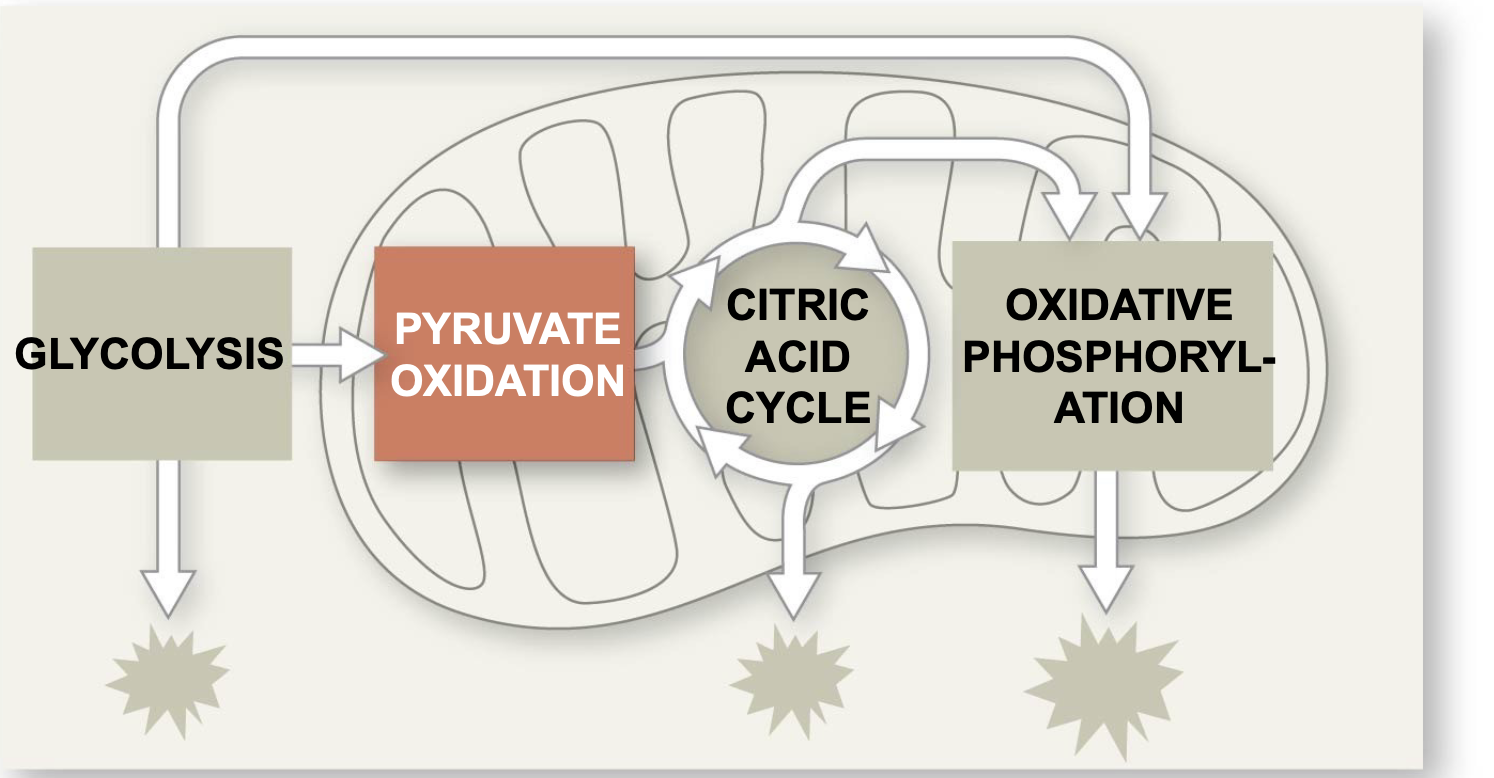
81
New cards
Stage 2: The Krebs Cycle
.The Krebs cycle (citric acid cycle) then carries out further redox reactions that break down the acetyl coA into CO2. \n • The Krebs cycle occurs in the matrix (innermost compartment) of the mitochondrion. \n • The redox reactions of the Krebs cycle produce more ATP, NADH, and FADH2. \n • The Krebs cycle transfers most of the energy that was in the glucose into NADH and FADH2.
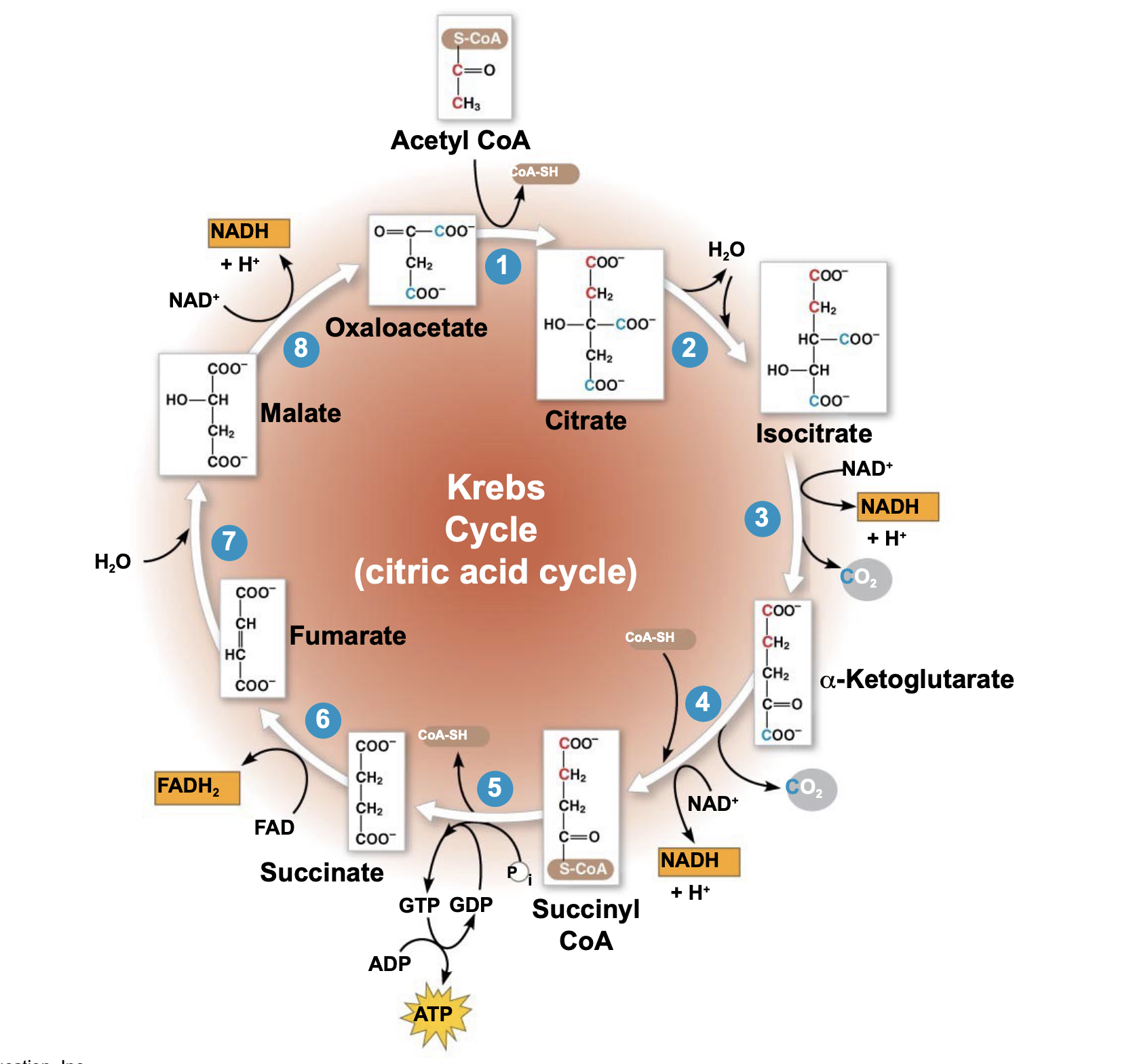
82
New cards
When the Krebs cycle (citric acid cycle) is completed
.the glucose has been entirely consumed (the 6 carbons in glucose have been converted into 6 CO2 molecules) \n • and the energy from breaking its chemical bonds has been transferred into a total of \n • 4 ATP molecules \n • 10 NADH electron carriers \n • 2 FADH2 electron carriers (this total = glycolysis + pyruvate oxidation + Krebs cycle)
83
New cards
electron transport chain
.Electrons (and the energy they carry) are transferred from NADH and FADH2 to the electron transport chain \n .The electron transport chain is made of proteins in the inner membrane (cristae) of the mitochondrion \n .This chain of proteins transfers electrons from one protein to the next. As the electrons are transferred, they provide energy to some of the proteins to perform active transport of H+ ions across the inner mitochondrial membrane. \n .The electron transport chain is thus powered by NADH and FADH2 and creates a concentration gradient of H+.
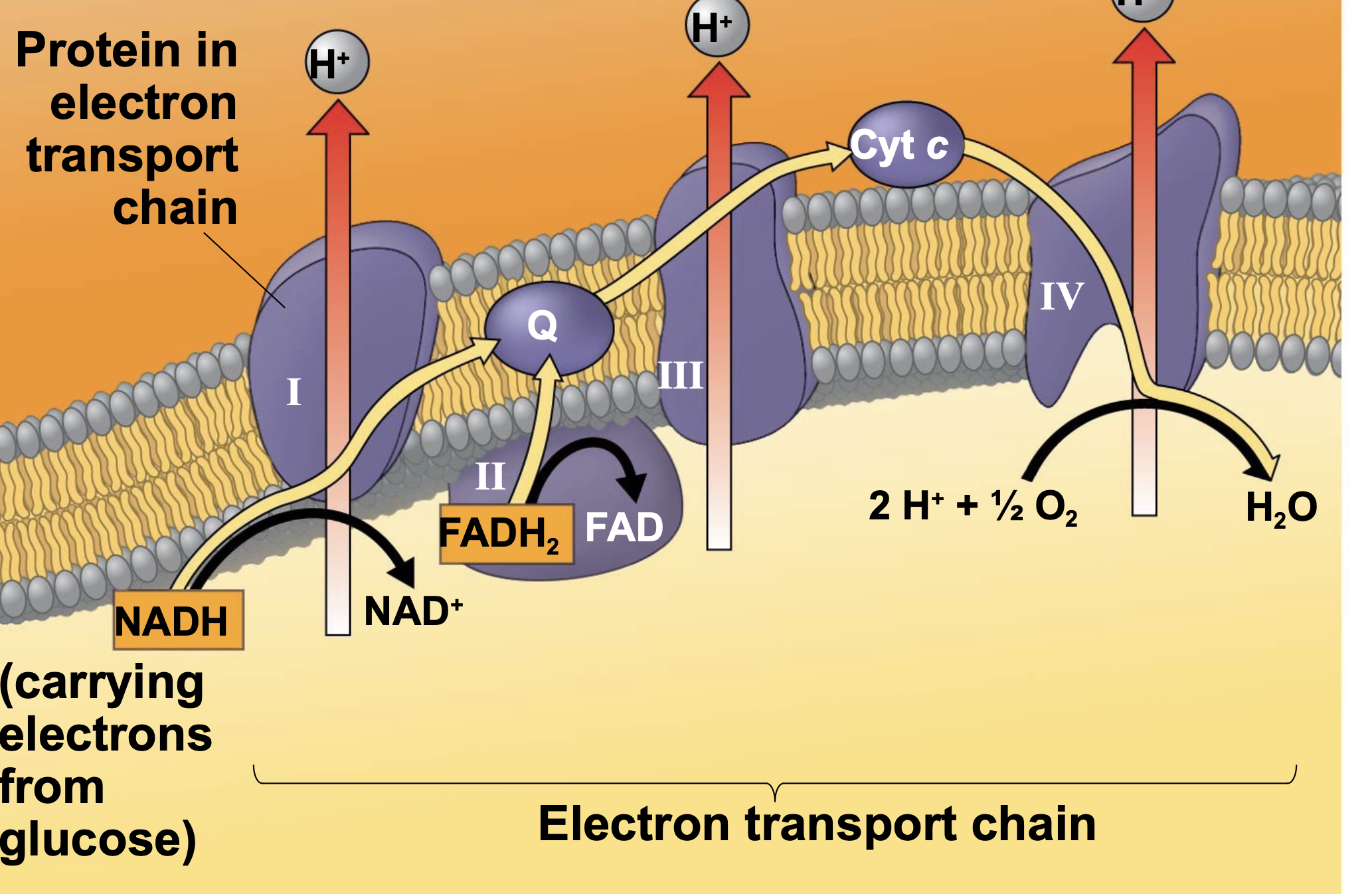
84
New cards
Chemiosmosis: The Energy-Coupling Mechanism
.Electron transfer in the electron transport chain causes proteins to pump H+ from the mitochondrial matrix into the intermembrane space \n .H+ then moves back across the membrane, passing through the enzyme ATP synthase \n .ATP synthase uses energy from the flow of H+ to produce ATP \n This is an example of chemiosmosis, the use of energy in a H+ gradient to drive cellular work

85
New cards
ATP synthase is powered by
the flow of H+ back into the mitochondrial matrix. It uses the energy from flowing H+ to add a phosphate to ADP to synthesize ATP.
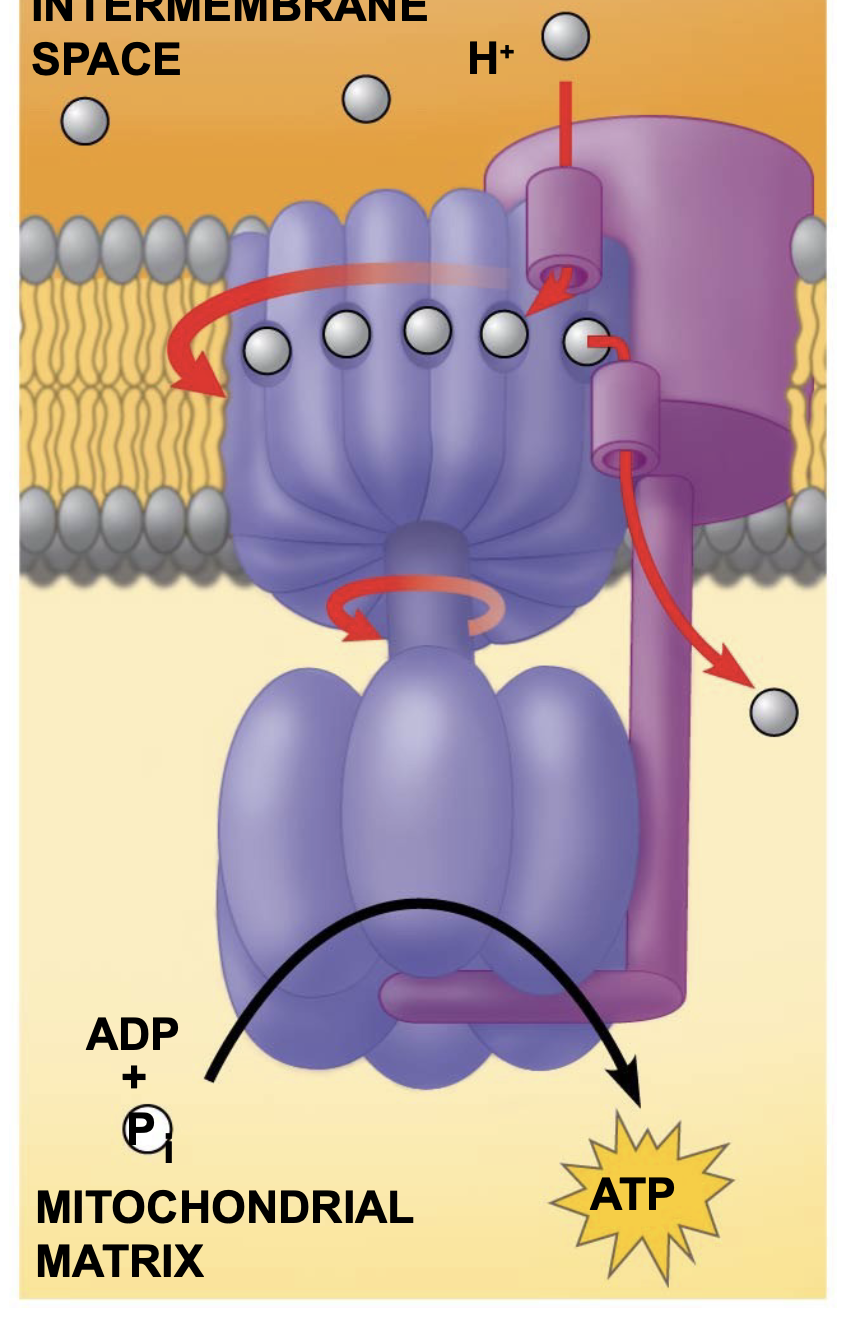
86
New cards
The Electron Transport Chain is Aerobic (Requires O2)
The last transport protein in the electron transport chain transfers electrons to oxygen which causes it to combine with H+ to form water. \n .This is why oxygen is a reactant of respiration, and why water is a product of respiration

87
New cards
used by electron transport chain and produced by electron transport chain
6O2 is used and 6 H2O is produced

88
New cards
by glycolysis/Krebs cycle (citric acid cycle) and produced by glycolysis/Krebs cycle (citric acid cycle)
C6H12O6 is consumed and 6CO2 is produced

89
New cards
The reason we breathe is
to provide oxygen to and remove carbon dioxide from cellular respiration taking place in the mitochondria of our cells. reactant of cellular respiration is O2 and product of cellular respiration is CO2.
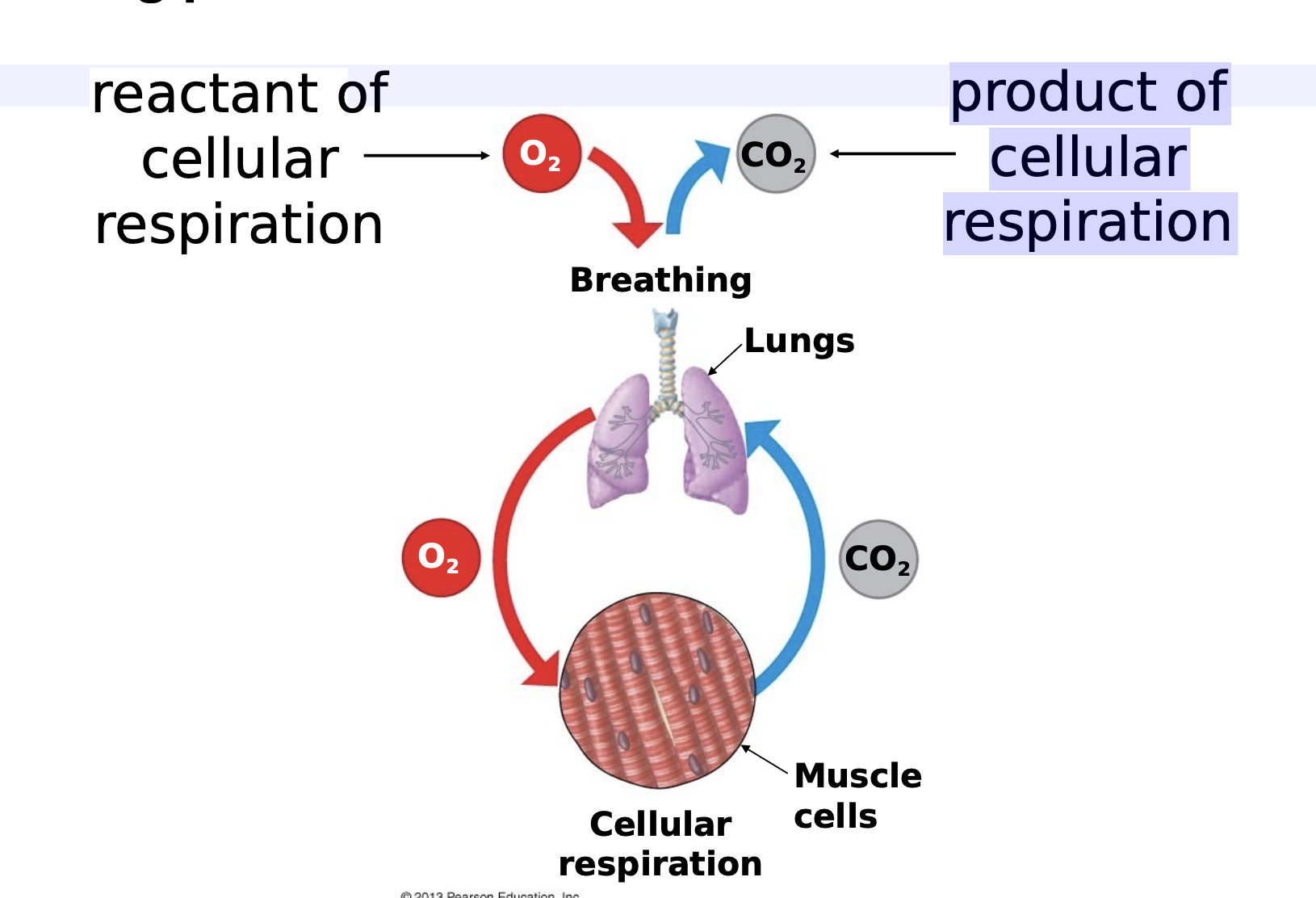
90
New cards
Many types of food molecules (not only \n glucose) can feed into cellular respiration. In addition to glucose we can process
Fats, Other carbohydrates, and Proteins. Cellular respiration can use many different types of food molecules.
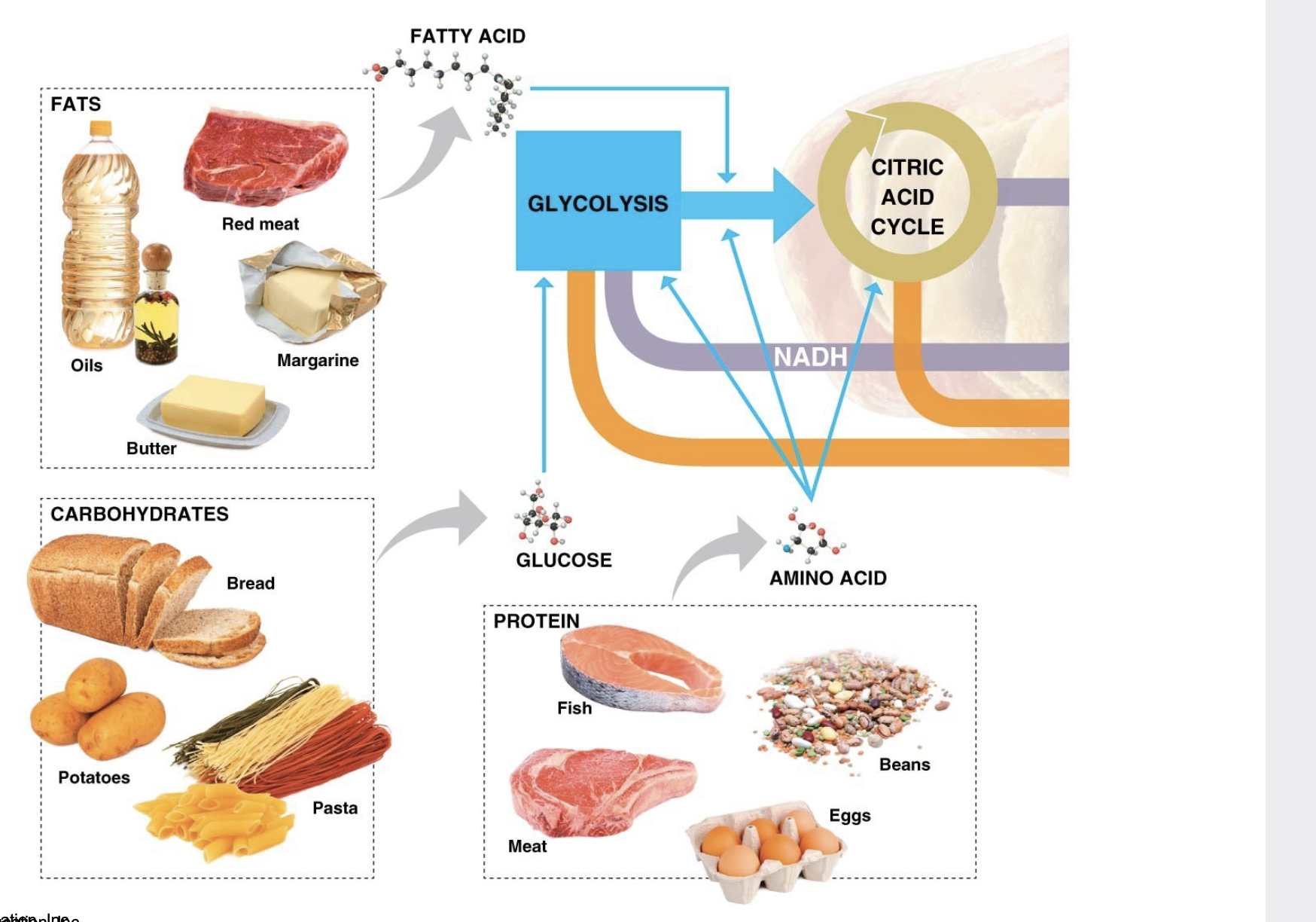
91
New cards
Fermentation is an anaerobic process to produce ATP
.When a cell uses fermentation, the only ATP that is produced from the energy in glucose is the ATP made by glycolysis. \n .Fermentation consists of glycolysis plus additional reactions that function to convert the NADH produced by glycolysis back into NAD+. These reactions, unlike oxidative phosphorylation, do not make any additional ATP. \n .Fermentation is thus very inefficient at making ATP compared to aerobic respiration. \n .Two common types of fermentation are alcohol fermentation and lactic acid fermentation
92
New cards
In alcohol fermentation
pyruvate is converted to ethanol in two steps \n ,The first step releases CO2 \n .The second step produces ethanol \n .Alcohol fermentation by yeast is used in brewing, winemaking, and baking
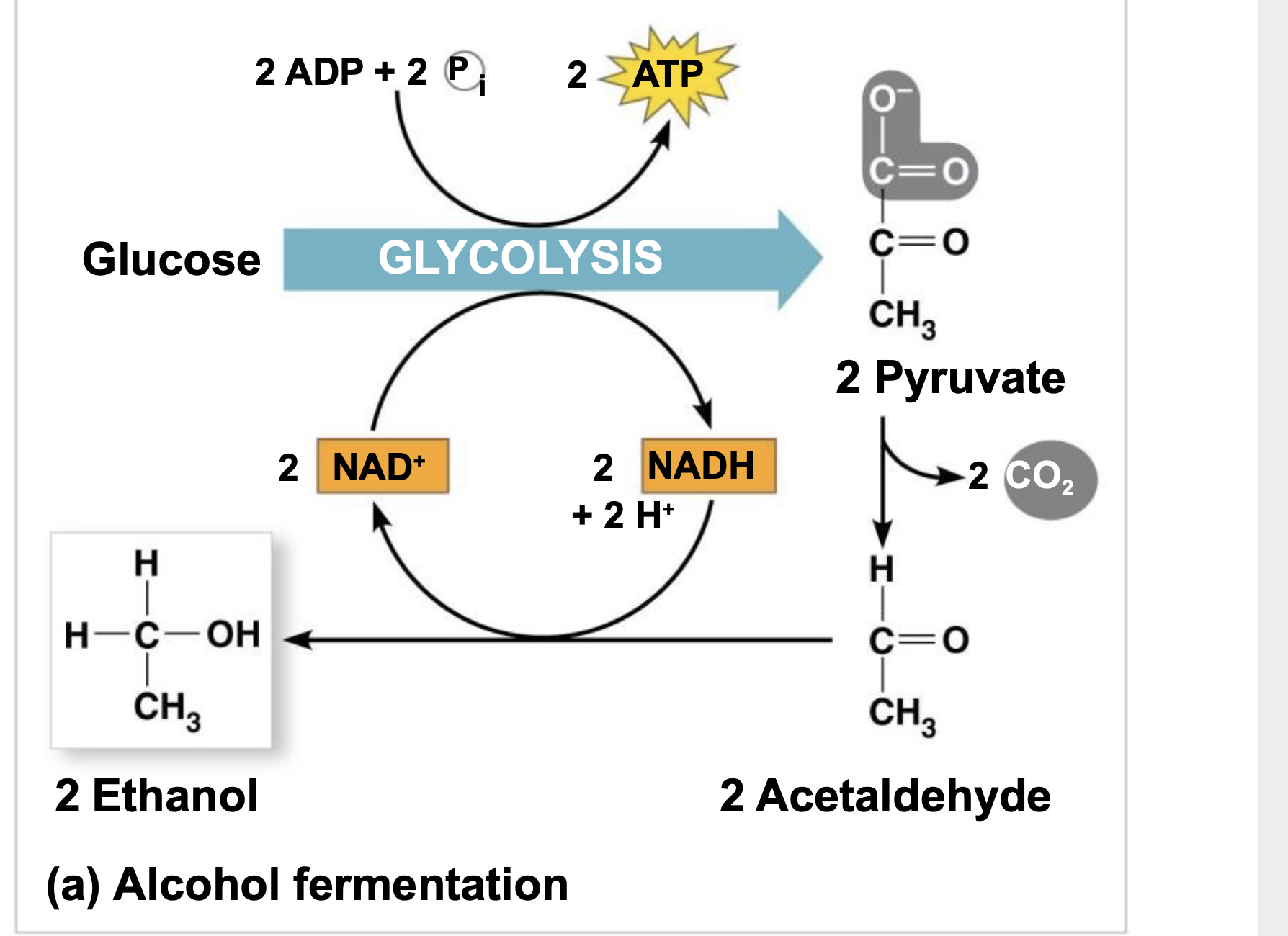
93
New cards
In lactic acid fermentation
.pyruvate is reduced by NADH, forming lactate as an end product, with no release of CO2 \n .Lactic acid fermentation by some fungi and bacteria is used to make cheese and yogurt \n .Human muscle cells use lactic acid fermentation to generate ATP when O2 is scarce
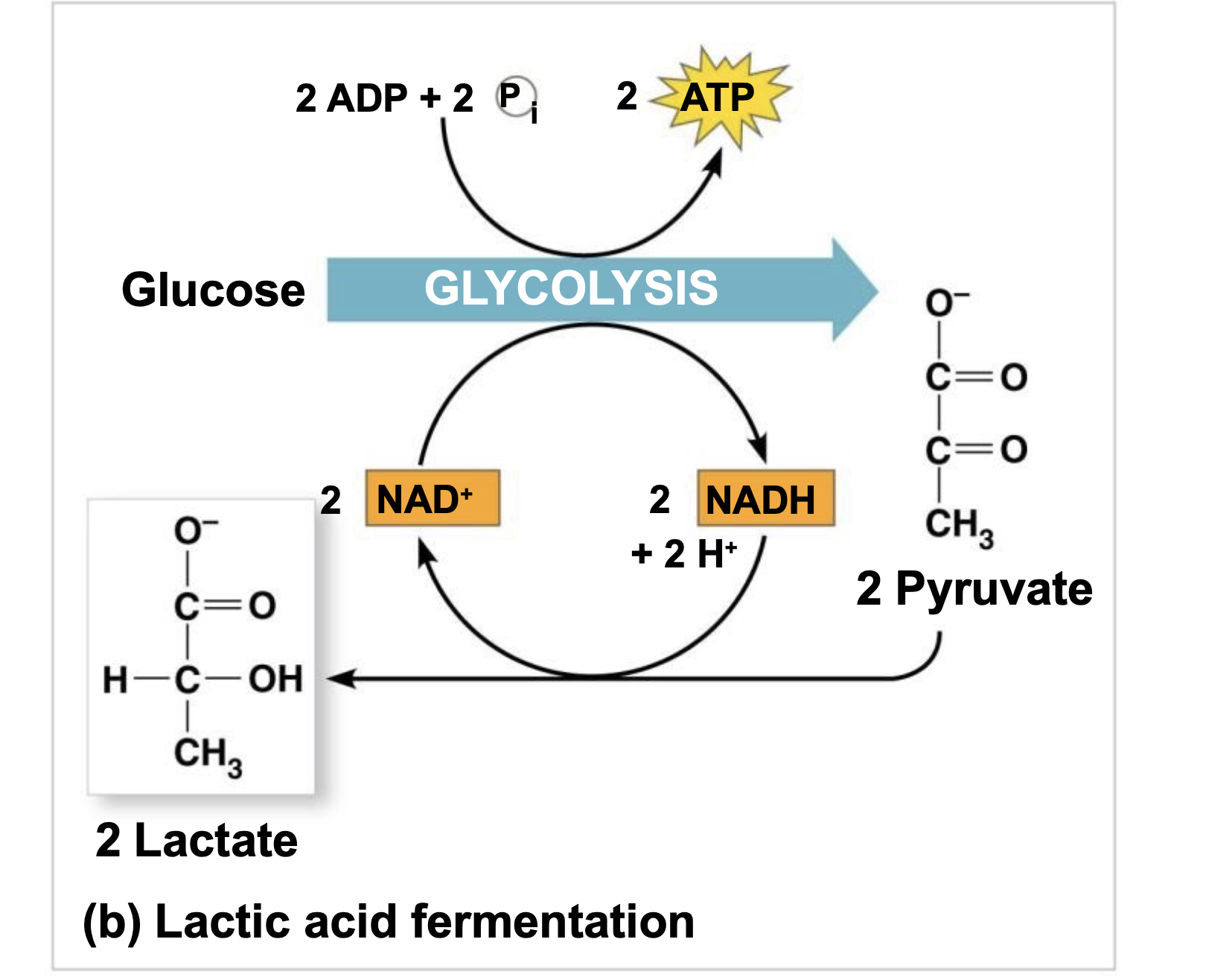
94
New cards
Obligate anaerobes
carry out fermentation or anaerobic respiration and cannot survive in the presence of O2
95
New cards
Facultative anaerobes
can either perform aerobic respiration if enough O2 is present or use fermentation if there is not enough O2 for aerobic respiration
96
New cards
obligate aerobes
Organisms, like humans, that depend on oxygen for aerobic respiration
97
New cards
facultative anaerobes
Yeast and many bacteria
98
New cards
The Process That Feeds the Biosphere
.Photosynthesis is the process that converts solar energy into chemical energy \n .Directly or indirectly, photosynthesis nourishes almost the entire living world

99
New cards
Autotrophs
sustain themselves without eating anything derived from other organisms
100
New cards
photoautotrophs
Plants are photoautotrophs, using the energy of sunlight to make organic molecules